Sites: news | india | latam | brasil | indonesia
Feeds: news | india | latam | brasil | indonesia
topic: Bats
Social media activity version | Lean version
Turning bat caves into sanctuaries: Interview with Mexican ecologist Rodrigo Medellín
- A hundred experts from Mexico, the United States and Canada worked together for the past two years to release the first report on the state of the 154 bat species that live in North America.
- The researchers concluded that the main threats that bats face in the region are the loss and disturbance of habitat, climate change impacts, wind farms, and the fungal disease white-nose syndrome.
- Mexico is home to 142 species of bats, whose protection researchers say hinges on protecting their habitat, including at least 15 caves that they propose designating as bat sanctuaries.
- Rodrigo Medellín, a Mexican researcher who helped coordinate the report, spoke with Mongabay Latam last July about why bats are so important for both nature and humans.
Study: Tall trees and shade boost bat diversity on Africa’s cocoa farms
- Insect-eating bats prefer cocoa farms that retain large, old-growth trees that mimic the natural forest conditions.
- New research found higher abundance and diversity of bats on farms with 65% or greater shade cover — still common on cocoa farms in places like Cameroon, but rare in major cocoa-producing areas of Ghana and Côte d’Ivoire.
- Related research has established that bats and birds can reduce the amount of pesticides cocoa farmers use, but also find yields decline where shade cover is greater than 30%.
- Researchers hope to find optimal levels of shade from native trees for agroforestry systems that provide homes for friendly bat and bird species while maximizing yields for farmers.
‘Small mammals play a big role’: Q&A with Nepali researcher Dibya Raj Dahal
- Nepal is renowned for its tigers, rhinos and snow leopards, but the country is also home to a rich diversity of smaller, less-studied mammals.
- These species have long gone overlooked and their research and conservation underfunded, even as they face threats from habitat loss, human-wildlife conflict and climate change.
- In 2008, a group of young Nepali researchers founded the nonprofit Small Mammals Conservation and Research Foundation (SMCRF) to shine a light on these species.
- Dibya Raj Dahal, a lifetime member of the SMCRF since 2009, is now its president, and shares the challenges the organization faces, as well as its hopes for greater recognition of the role of small mammals in Nepal.
Birds and bats help Peruvian cacao farmers gain higher yields, study says
- Birds and bats accounted for 54% of total cacao tree productivity over a one year period in northern Peru’s agroforestry systems.
- The economic benefits of bird and bat contributions in the study area amount to approximately $959 per hectare per year for Peruvian cacao farmers who grow the Blanco de Piura variety of fine-flavor cacao.
- Experimentally excluding birds and bats increased pest damage and reduced cacao yields, emphasizing their valuable “pest predation service” that benefits farmers.
- The presence of nearby forests is crucial for maintaining high cacao yields, as they support bird diversity, which helps mitigate the negative effects of ants and other pests on cacao trees.
In Nepal, Chepang take up the challenge to revive their cultural keystone tree
- In Nepal, the Chepang people have long relied on the chiuri tree (Diploknema butyracea or Indian butter tree) for timber, fuelwood and butter.
- According to folklore, the Chepang tribe, the chiuri tree and bats are all part of a three-pronged system of survival, as each helps the other two; that system — and the chiuri tree — has fallen to the wayside.
- Now, young Chepangs are trying to revive the chiuri tree and market the valuable fruits.
Flooding for hydropower dams hits forest-reliant bats hard, study shows
- Researchers have found that bats specialized to feed on insects within the dense canopy of tropical forests are disproportionately affected by hydropower development.
- The study in Peninsular Malaysia adds to a growing body of evidence demonstrating how hydropower developments impoverish tropical ecosystems.
- Although forest-specialist bats were lost from the flooded landscape, bats that forage along forest edges and in open space were still present.
- To minimize localized extinctions, the researchers advocate a preventive rather than mitigative approach to hydropower planning that prioritizes habitat connectivity and avoids creating isolated forest patches.
Social media can be a bat’s best friend (commentary)
- Bats provide many ecosystem services, yet their populations are declining due to habitat loss, climate change, hunting, and disease.
- Social media allows conservationists to collect large amounts of data, study human-nature interactions, understand conservation debates and discussions, and increase the public’s knowledge of their conservation.
- Public engagement with bat-friendly social media posts may boost appreciation of these species, and can be an influential part of conservationists’ efforts to inform and inspire the public to participate in their conservation.
- This post is a commentary. The views expressed are those of the author, not necessarily of Mongabay.
Community conservation benefits Sulawesi flying foxes, but more is needed, experts say
- Flying foxes play a vital role in maintaining forest health. As pollinators and seed dispersers they are also invaluable to the economic and social well-being of communities.
- In Indonesia’s Sulawesi, conservation groups are working to protect flying foxes, which face threats including hunting for food and habitat loss.
- Community-led approaches are showing success, but conservationists say greater protection and an expansion of projects is needed to protect more bat roosts.
Forests & finance: Setbacks for a rare bat, and progress for an oil pipeline
- As much as three-quarters of forests flanking Mozambique’s Mount Namuli have been lost since 2006, researchers say, threatening the newly described Namuli horseshoe bat.
- Environmentalists fear a new pipeline linking oil fields in Niger to the Atlantic coast in Benin will damage forest and wetland habitat along its length.
- Forests & Finance is Mongabay’s bi-weekly bulletin of briefs about Africa’s forests.
New cave bat species in Sri Lanka highlights need for more research
- Researchers describe a new bat species found in Sri Lanka and South India and name it Miniopterus phillipsi in honor of British naturalist W.W.A. Phillips.
- Sri Lanka is home to 31 species of bats, but researchers say there could be more given that neighboring India has 132 bat species already described.
- The number of identified species in the genus Miniopterus has doubled in Africa, but in Asia, M. phillipsi is the first new addition to this genus after a lapse of six decades.
- M. phillipsi is a small, insectivorous bat previously identified as Miniopterus fuliginosus; it inhabits caves and its population remains stable, although habitat loss may soon impact these bats.
Education can change local perception of bats, help conserve species, study says
- Researchers in North Sumatra found that local farmers’ awareness of bats’ role in pollinating durian crops was low.
- Some bat species are in decline in the study area, partly due to hunting.
Seeing through the swarm: How hawks hunt bat prey
- How do hawks and raptors hunt prey that flock, school or swarm? A new study suggests that rather than homing in on one animal, they aim toward a fixed point in space within a swarm.
- Researchers observed Swainson’s hawks and other raptors hunting amid swarms of nearly a million Mexican free-tailed bats as they left their roosting cave in the Chihuahuan desert in New Mexico, U.S.
- The researchers positioned high-definition video cameras around the mouth of the cave, allowing them to reconstruct in 3D the trajectories of the hawks’ attacks on the bats from the 2D video recordings.
- This study offers an explanation of how large groups of prey that appear confusing to human eyes because of their erratic movements don’t necessarily result in a confusion effect in predators.
‘Comical’ bat not seen in 40 years is found again in a Rwandan park
- For the first time in 40 years, researchers caught a Hill’s horseshoe bat, confirming that the bat population still clings to life in Rwanda’s Nyungwe National Park, a highly biodiverse area containing old-growth cloud forest.
- Rhinolophus bats echolocate through the unique and exaggerated folds on their noses called “nose leaves,” which, in the case of the Hill’s horseshow bat, gives them a bass frequency, unlike the soprano of other horseshoe bats.
- Now that researchers have identified their call, they can use acoustic monitoring to eavesdrop on the critically endangered species with minimal impact.
- A lead researcher on the team said the bats are likely restricted to a core area, and although the park is well-patrolled by rangers, this area should be a focus in order to protect the remaining bats, whose population remains unknown.
Top 15 species discoveries from 2021 (Photos)
- Science has only just begun to find and describe all of the species on Earth; by some estimates, only 20% have been described.
- This year, Mongabay reported on newly described species from nearly every continent, including an Ecuadoran ant whose name broke the gender binary, an acrobatic North American skunk, an Australian “killer tobacco,” a fuzzy orange bat from West Africa, tiny screech owls from Brazil, and more.
- Though a species may be new to science, that doesn’t mean it has not yet been found and given a name by local and Indigenous communities.
‘To change policies, insert yourself in them’: Q&A with biologist Liliana Dávalos
- Colombian biologist Liliana Dávalos has combined conservation research with evolutionary ecology from her laboratory at Stony Brook University.
- Dávalos was one of the first scientists to warn, in 2001, about the environmental risks that an eventual end to the civil war in Colombia would have — a scenario that is now playing out as Colombia’s forests are being opened up for commercial activity.
- Bats are another of Dávalos’s subjects of study: In addition to deciphering their genome to understand their evolution in space and time, more recently Dávalos has studied the relationship of these flying mammals with pathogens such as coronaviruses.
- In an interview with Mongabay, Dávalos, who is openly gay, also talks about attitudes in academia toward women and lesbians, and sends a message to young researchers not to be blinded by the awareness of obstacles.
Biosurveillance of markets and legal wildlife trade needed to curb pandemic risk: Experts
- Almost 90% of the 180 recognized RNA viruses that can harm humans are zoonotic in origin. But disease biosurveillance of the world’s wildlife markets and legal trade is largely absent, putting humanity at significant risk.
- The world needs a decentralized disease biosurveillance system, experts say, that would allow public health professionals and wildlife scientists in remote areas to test for pathogens year-round, at source, with modern mobile technologies in order to help facilitate a rapid response to emerging zoonotic disease outbreaks.
- Though conservation advocates have long argued for an end to the illegal wildlife trade (which does pose zoonotic disease risk), but the legal trade poses a much greater threat to human health, say experts.
- Governments around the world are calling for the World Health Organization to create a pandemic treaty. Wildlife groups are pushing for such an agreement to include greater at-source protections to prevent zoonotic spillover.
The Covid-19 question: How do we prevent future pandemics?
- The EndPandemics alliance brings together various groups working to prevent future zoonotic disease outbreaks by ending the wildlife trade and the destruction of nature, and transforming agriculture.
- Its founders say wildlife markets, such as the one in Wuhan from where COVID-19 is believed to have originated, are ticking time bombs where animal-borne viruses can enter the human population.
- Also helping drive humans and wildlife into closer contact is deforestation, including for agriculture such as oil palm; a bat found near an oil palm plantation in Guinea is believed to have sparked the worst outbreak yet of Ebola.
- EndPandemics’ founders say these destructive practices are allowed to persist because they’re lucrative, but argue that the cost of dealing with the COVID-19 pandemic is far greater.
‘Spectacular’ orange-furred bat described from West African mountain
- An orange-furred bat has been described from the caves and mining tunnels of the Nimba Mountains in Guinea.
- Researchers say the bat had such a distinctive look that they quickly recognized it was a species new to science.
- The newly described species, which they named Myotis nimbaensis, meaning “from Nimba,” may also be critically endangered and found only in this particular mountain range.
- This discovery, the authors say, speaks to the importance of the Nimba peaks, known as “sky islands,” to bat diversity.
Top positive environmental stories from 2020
- 2020 was a difficult year for many, but positive stories emerged.
- This year, species were brought back from the edge of extinction; interest in renewable energy surged; environmental monitoring technology improved; new protected areas were created; and a few Indigenous women leaders got some long-overdue credit and recognition.
- In no particular order, we look back at some of our top positive environmental stories from 2020.
Does Lucius Fox know? Tiny tech tracks bats (and more)
- A newly developed tracking device that fits like a tiny backpack allows scientists to monitor small animals.
- The wireless biologging network (WBN) device allows for proximity sensing, high-resolution tracking, and long-range remote data download all at the same time.
- The capability of the WBN device to track associations is providing scientists with new insights into animal behavior and conservation solutions.
- The device, weighing just 2 grams (0.07 ounces), is designed to be glued onto the back of animals like bats and eventually fall off after a few weeks.
Endangered bats are evolving to fight off an exotic fungal disease
- Little brown bats, an endangered species, have declined by more than 90% due to white-nose syndrome, a fungal disease that causes bats to wake up from hibernation, and consequently drains their essential fat reserves.
- A new study uses genetics to determine that little brown bats with certain genetic traits are more likely to survive the disease.
- Research on genetically resistant bats could help inform conservation efforts to save the little brown bat and other bat species affected by the syndrome.
Bats: Resistant to viruses, but not to humans
- Despite the many benefits they provide to the planet, bats are subject to unjustified stigmas and beliefs.
- These are being further aggravated by a widespread belief that bats caused the COVID-19 outbreak.
- However, scientists say that bats are not responsible for the pandemic.
- Rather, wildlife trafficking and the destruction of ecosystems have increased the possibility of humans coming into contact with viruses present in various animal species.
In defense of bats in a COVID world (commentary)
- Bats seem to be among the least popular of all animals. Covid-19 hasn’t helped their reputation. But we’ve gotten them all wrong. As you drink a Margarita, think of why that may be.
- Through pest-control, pollination, and seed dispersal of agricultural crops, bats play a critical role in our collective well-being, yet they are commonly scapegoated and persecuted as vectors of disease, writes Enrique G. Ortiz, Senior Program Director at the Andes Amazon Fund.
- The time has come for us to recognize bats contributions and treat them as the magnificent creatures they are, he argues. We need to protect them and their habitats.
- This post is a commentary and does not necessarily reflect the views of Mongabay.
Young Nigerian researcher goes to bat against forest fires
- The discovery in 2016 of a rare bat never before seen in Nigeria sparked a campaign to protect its habitat from the threat of forest fires, typically started by farmers clearing land or hunters dropping lit cigarettes in the vegetation.
- Through their Small Mammal Conservation Organization (SMACON) and its Zero Fire Campaign, biologists Iroro Tanshi and Benneth Obitte worked with local communities around the Afi Mountain Wildlife Sanctuary to end the burning and educate on bat conservation.
- No fires were recorded in the region in the past three years, except for a single incident last month, as the campaign continues to instill “the consciousness of how big a deal this is,” Tanshi says.
- In recognition of her work and dedication, Tanshi was named among the winners of this year’s Future for Nature Foundation’s awards for young conservationists; she says the prize money will go toward protection and further studies of the short-tailed roundleaf bat.
In the Philippines’ Boracay, flying foxes are going, going, gone
- A recent survey counted just 30 resident bats on the Philippine resort island of Boracay, down from 15,000 in 1988.
- Boracay has been subject to a massive rehabilitation effort after pollution and runaway development prompted President Rodrigo Duterte to close the island to tourism for six months in 2018.
- The closure does not seem to have benefited the bats, including the endemic golden-crowned flying fox (Acerodon jubatus), one of the world’s largest fruit bat species, which is classified as critically endangered on the IUCN Red List.
- Bat conservationists have persistently recommended declaring the island’s remaining forest cover as critical habitats for threatened bats, but formal recognition hangs in the balance as rehabilitation efforts end this May.
What one of the world’s most active volcanoes tells us about missing trees
- Lava flows from the Piton de la Fournaise, one of the most active volcanoes in the world, are helping scientists study the long-term impacts of human settlement on forests on La Réunion, an island off the eastern coast of Africa.
- The disappearance of large frugivores like giant tortoises and flying foxes from the island by the end of the 18th century after humans settled permanently on the island has shaped its plant communities as well.
- A group of researchers at the University of La Réunion looked at eruptions dated between 1401 and 1956, to study how plant recovery differed following lava flows that took place before human settlement and after.
- They found that large-fruited trees faded away from the landscape after the animals that were capable of dispersing their seeds were lost because of overhunting, habitat loss and introduction of invasive species by human settlers.
Philippine fruit bats may be entirely new species of their own, DNA suggests
- A recently published genetic study on fruit bats found in the Philippines revealed high genetic difference among island groups and compared to the Southeast Asian region, which could mean they either need to be reclassified as subspecies or be elevated as new species.
- The study covered 19 of the 27 fruit bat species native to the Philippines, which were assessed using a DNA barcoding technology in a six-year study.
- Five of the species were revealed to have 6 to 7% genetic distance from specimens elsewhere in Southeast Asia, possibly justifying the need to name them distinct populations of their own, the researchers say.
- DNA barcoding is part of a growing international effort to create a genetic database to improve wildlife forensics, aid in curbing wildlife trafficking and help implement more efficient species-focused conservation efforts.
Cambodian “bat man” bolsters the fight against dengue fever
- Rising temperatures due to climate change allow mosquitoes carrying deadly malaria and dengue fever to live in new parts of the world that were previously uninhabitable, placing over half the world’s population at risk.
- Creating artificial roosts for bats to “farm” their guano can improve soil quality, providing a natural fertilizer while reducing insect numbers, and possibly disease burdens.
Nail paint helps researchers estimate numbers of rare Cuban bat species
- Very little is known about the Cuban greater funnel-eared bat (Natalus primus), an extremely rare species known from just a single remote cave in western Cuba.
- Now, following a survey that involved bright nail paints to mark individual bats, researchers have estimated that there are fewer than 750 Cuban greater funnel-eared bats in the the cave locally known as Cueva la Barca.
- What the population number means for the species is, however, hard to say at the moment because of the lack of any previous estimates, researchers say.
Tiny tracking tags help decode how echolocating bats navigate
- Although navigation in echolocating bats has been studied for a long time, questions remain on how bats differentiate among echoes from different objects.
- Researchers designed a small, lightweight tag that can capture movement and sound information in three dimensions to create a map of a bat’s sensory environment.
- The data helped researchers pinpoint the movements of bats during flight and while catching prey, as well as how echoes from various objects differ.
- One-third of bat species are threatened with extinction or lack basic ecological data, so such information can help scientists and wildlife managers understand bats’ foraging behavior and develop better measures for their conservation.
On a wing and a prayer? Evidence for ways to conserve bats (commentary)
- Globally, around a quarter of bat species are threatened by factors including habitat loss, roost destruction, hunting, and climate change.
- To find the most effective ways of conserving these creatures, researchers at Conservation First, the University of Leeds, and the University of Cambridge (where I work) have updated a report that gathers together information on how well attempts to conserve bats actually worked.
- While the new bat synopsis gathers more information than ever before on ways to reduce the impact of developments from roads to lighting and from farming to forestry, it still highlights shocking gaps in the evidence.
- This post is a commentary. The views expressed are those of the author, not necessarily Mongabay.
Latam Eco Review: Bolivia’s Batman and Peru’s birdy cave drawings
 A biologist known as Bolivia’s Batman, ground zero for Amazon deforestation in Peru, and camera traps showing the bird species from ancient cave drawings were among the top stories from our Spanish-language service, Mongabay Latam. Bolivia’s Batman: “There are many more bat species here” “Colombia gets the gold medal” for having the highest number of […]
A biologist known as Bolivia’s Batman, ground zero for Amazon deforestation in Peru, and camera traps showing the bird species from ancient cave drawings were among the top stories from our Spanish-language service, Mongabay Latam. Bolivia’s Batman: “There are many more bat species here” “Colombia gets the gold medal” for having the highest number of […]
In the Solomon Islands, making amends in the name of conservation
- The Kwaio people of the Solomon Islands have been working with scientists to protect their homeland from resource extraction and development.
- But violent clashes in 1927 between the Kwaio and the colonial government created a rift between members of this tribe and the outside world.
- To heal those old wounds and continue with their conservation work, a trio of scientists joined the Kwaio in a sacred reconciliation ceremony in July 2018.
- Kwaio leaders say that the ceremony opened the door to a more peaceful future for their people.
Jammin’ at wind farms may help save bats
- Hundreds of thousands of bats are killed by wind turbines each year in North America.
- New technology that uses an ultrasonic acoustic field to jam bat echolocation was found to reduce bat fatalities by 54 percent at a wind energy facility in Texas.
- The Bat Deterrent System will be released commercially in North America this year.
- Tests are ongoing to maximize the system’s effectiveness for various bat species.
Culls push endangered fruit bat closer to extinction in Mauritius
- The government of Mauritius plans to cull 20 percent of the population of Mauritian flying foxes (Pteropus niger) in 2018 to protect farmers’ fruit trees.
- Culls in prior years led to the extermination of tens of thousands of the bats, and the IUCN now lists the species, which lives only in Mauritius and perhaps a few nearby islands, as endangered.
- A recent study found that, while bats (along with birds) do take a toll on farmers’ orchards, nets over the trees when the fruit ripens can dramatically diminish the damage they do.
Photos: Here are the winners of the 2018 British Ecological Society photo contest
- Chris Oosthuizen of South Africa’s University of Pretoria won the top prize in the British Ecological Society’s “Capturing Ecology” photo competition this year with an image of a single colorful adult king penguin amidst a crowd of brown-colored chicks on Marion Island, part of the Prince Edward Islands in the Indian Ocean.
- Oosthuizen is hopeful that the prize-winning photo might help draw attention to the challenges king penguins face due to the impacts of human activities. “Although the global population of king penguins is large, populations inhabiting islands around the Antarctic face an uncertain future,” he said.
- In total, some 16 images were recognized this year by the British Ecological Society. “Capturing flora and fauna from across the planet, subjects range from African wild dog research to an artistic take on Galapagos iguanas to images exploring the relationships between people and nature,” the group said in a statement.
Bat Week: the super powers of bats (photos)
- This photo post comes via Mongabay’s partnership with the Wildlife Conservation Society’s Wild View blog.
- Under this partnership, we publish occasional original contributions from Wild View that highlights an animal species or group.
- In this post, the Wildlife Conservation Society’s Sarah H. Olson and Julie Larsen Maher write about bats on the occasion of Bat Week, which runs from October 24-31.
Decoding the language of bats key to their conservation
- Uruguayan scientists have developed a new artificial intelligence algorithm and reference library of bat ultrasound pulses to enable the use of acoustic monitoring of this understudied regional fauna.
- Bats in the Southern Cone are threatened by wind turbines, but their species and sonar emissions differ from other areas, requiring the scientists to build their own acoustic library and predictive algorithms.
- The scientists are collaborating with wind farm companies and international academics to help expand the reference library and improve the algorithm’s accuracy and speed.
Audio: How an African bat might help us prevent future Ebola outbreaks
- On this episode, we look at research into an African bat that might be the key to controlling future Ebola outbreaks.
- Our guest is Sarah Olson, an Associate Director of Wildlife Health for the Wildlife Conservation Society. With Ebola very much in the news lately due to a recent outbreak in the Democratic Republic of Congo, Olson is here to tell us how research into hammer-headed fruit bats might help us figure out how Ebola is transmitted from animals to humans — and potentially control or prevent future outbreaks of the viral disease.
- The bats don’t contract the disease, but there is evidence that they carry the virus. Olson is part of a study in the Republic of the Congo that seeks to understand how the Ebola virus is transmitted from carriers like hammer-headed fruit bats to other wildlife and humans.
Making the most of conservation science (commentary)
- Increasing numbers of scientific papers on conservation are published every year, but for many people these remain inaccessible behind paywalls, difficult to locate in a vast ocean of research, or time-consuming to read.
- There are increasing attempts to bring the evidence for particular questions together in digestible formats, such as systematic reviews or Mongabay’s Conservation Effectiveness series. One such enterprise is the Conservation Evidence project, which assesses the evidence for the effectiveness of conservation interventions.
- A new edition of the book ‘What Works in Conservation,’ produced by Conservation Evidence, is available and free to download. This book helps us to see which conservation interventions have been shown to work, which have been shown not to work, and where we need more evidence.
- This post is a commentary. The views expressed are those of the author, not necessarily Mongabay.
New study: Radar reveals bats are a bellwether of climate change
- New research indicates that bats could signal seasonal shifts due to climate change.
- The study, published in the journal Global Change Biology, is the first to use radar to track an animal migration.
- The scientists found that bats that migrate between Mexico and a cave in Texas are now arriving about two weeks earlier than they did in 1995.
Two new dog-faced bats discovered in Panama and Ecuador
- Researchers have described two new species of dog-faced bats: the Freeman’s dog-faced bat (Cynomops freemani) from Panama and the Waorani dog-faced bat (Cynomops tonkigui) from Ecuador.
- The Freeman’s dog-faced bat was named after bat specialist Patricia Freeman.
- The species name of the Waorani dog-faced bat, “tonkigui,” honors the Waorani tribe of Ecuador that lives near one of the locations where the bats were captured, the study says.
Friend, not foe: Review highlights benefits of predators and scavengers
- Predators are typically better known for harassing pets and livestock or being the source of disease than they are for the valuable — and often less visible — services they provide.
- A review published in the journal Nature Ecology and Evolution catalogs benefits provided by predators to humans documented in the scientific literature.
- Authors of the review highlighted instances that ranged from the potential for mountain lions to cut down deer-vehicle collisions, bats that save corn farmers at least $1 billion annually, and vultures that clear away tons of organic waste.
How a hunger for teeth is driving a bat toward extinction
- Bat teeth are more valuable than paper money on the island of Makira, in the eastern Solomon Islands.
- The use of bat teeth as a currency means that bats on the island are commonly hunted. One species, the Makira flying fox, is found only on the island and is being threatened with extinction due to human pressures.
- In addition to direct hunting, human population growth and logging are also threatening the bats.
- To save the species, researchers recommend developing quotas for sustainable harvesting, as well as an outreach campaign connecting the survival of this key piece of Makiran culture with the need to conserve the bats.
Audio: Indonesian rainforests for sale and bat calls of the Amazon
- This episode of the Mongabay Newscast takes a look at the first installment of our new investigative series, “Indonesia for Sale,” and features the sounds of Amazonian bats.
- Mongabay’s Indonesia-based editor Phil Jacobson joins the Newscast to tell us all about “Indonesia for Sale” and the first piece in the series, “The palm oil fiefdom.”
- We also speak with Adrià López-Baucells, a PhD student in bat ecology who has conducted acoustic studies of bats in the central Amazon for the past several years. In this Field Notes segment, López-Baucells plays some of the recordings he used to study the effects of Amazon forest fragmentation on bat foraging behavior.
Bats key pollinators for durian production, camera traps confirm
- A new study employing camera traps indicates that flying foxes in Malaysia are important pollinators of commercially valuable durian fruit trees.
- The researchers set 19 traps in semi-wild durian trees.
- Their investigation revealed that the bats had a positive impact on the transformation of the flower to fruit.
Audio: Legendary musician Bruce Cockburn on music, activism, and hope
- Music has a unique ability to inspire awareness and action about important issues — and we’re excited to welcome a living legend onto the program to discuss that very topic.
- Bruce Cockburn, well known for his outspoken support of environmental and humanitarian causes, appears on this episode of the Mongabay Newscast.
- Our second guest is Amanda Lollar, founder and president of Bat World Sanctuary, a wildlife rehabilitation center in Texas.
- All that plus the top news!
Bats and viruses: Beating back a bad reputation
- Ecologist Merlin Tuttle argues that too much research and media attention is focused on bats based on tenuous links to deadly disease-causing viruses such as Ebola.
- Live Ebola virus has never been found in bats, and virologists acknowledge that other animals may be involved.
- But scientists have plucked live strains of other dangerous viruses from bats, and researchers argue that continuing to study the association between viruses and bats (as well as other animals) will ultimately help us better prepare for future disease outbreaks.
‘Yoda bat’ happy to be recognized as new species
- A new fruit bat species found in the rainforests of Papua New Guinea and described in the Records of the Australian Museum this month resembles Yoda closely enough that it has actually been referred to simply as the “Yoda bat” — at least until now.
- Acccording to Nancy Irwin, author of the study describing the species, the name Hamamas or “happy” tube-nosed fruit bat was chosen because “Most of the morphological characteristics that separate this bat from other species are associated with a broader, rounder jaw which gives the appearance of a constant smile.”
- The bat was given its scientific name, N. wrightae, in honor of conservationist Deb Wright, who spent two decades building conservation programs and long-term scientific capacity in Papua New Guinea.
Nearly one-third of bat species in North America are on the decline
- Scientists with NatureServe, an international biodiversity conservation NGO, looked at the conservation status of the 45 species of bat that occur in North America north of Mexico.
- Using a methodology for assessing conservation status developed by NatureServe, the researchers determined that, as of 2015, more than 30 percent of the 45 bat species included in the study qualified as vulnerable, imperiled, or critically imperiled.
- The authors of the study say that the rapid spread of a deadly fungal disease called white-nose syndrome has killed several million cave-dwelling bats of multiple species in eastern North America over the past decade.
Study examines sex-specific responses of Neotropical bats to habitat fragmentation
- While scientists have long known that males and females of some species use their habitat in different ways, the various responses to habitat destruction that are sex-specific are less well understood.
- Research published in the journal Biotropica this month looked at the different responses to the effects of fragmentation exhibited by male and female individuals of Seba’s Short-tailed Bat (Carollia perspicillata) and the Dwarf Little Fruit Bat (Rhinophylla pumilio), both fruit-eating bats native to the Neotropics.
- Researchers captured more than 2,000 bats of the target species in eight forest fragments of various sizes and nine control sites at the Biological Dynamics of Forest Fragments Project, a research forest about 80 kilometers north of Manaus in the Brazilian Amazon.
- The authors of the study write that their results align with those of previous research in temperate areas, where male and female bats have been found to differ in their responses to habitat degradation at the local and landscape level.
Conservation community failing to use evidence to make decisions, scientists say
- In a new article, scientists have coined the term “evidence complacency” to highlight the persistence of a culture in which, “despite availability, evidence is not sought or used to make decisions, and the impact of actions is not tested.”
- This complacency can not only lead to a wastage of money, time and opportunities, but also show conservation as an unjustifiable investment, the researchers say.
- Conservation practitioners say that scientists need to collaborate more with decision makers and look at evidence more broadly than just peer-reviewed studies.
New leaf-nosed bat uncovered amidst burning habitat in Venezuela
- Using genetic and morphologic comparisons, scientists uncovered a new leaf-nosed bat species they named Sturnia adrianae. The species inhabits montane forest in northern Venezuela and Colombia.
- The species is comprised of two subspecies, one of which is restricted to an isolated mountain range in northeastern Venezuela where human-caused fires are common.
- The study’s lead author recommends increasing conservation and scientific attention for the area to preserve bat habitat, safeguard water supplies, and help prevent landslides like those that recently killed at least 250 people in Mocoa, Colombia.
Scientists launch expedition to find missing monkeys
- Vanzolini’s bald-faced saki hasn’t been seen since scientists first discovered it in western Brazil in the 1930s.
- Navigating along the Rio Juruá and its tributaries, the expedition will be the first comprehensive biological survey of the region.
- Its international team of researchers hopes to uncover the saki, as well as other yet-undocumented species, while calling conservation attention to the river and surrounding rainforest.
‘Running out of time’: 60 percent of primates sliding toward extinction
- The assessment of 504 primate species found that 60 percent are on track toward extinction, and the numbers of 75 percent are going down.
- Agricultural expansion led to the clearing of primate habitat nearly three times the size of France between 1990 and 2010, impinging on the range of 76 percent of apes and monkeys.
- By region, Madagascar and Southeast Asia have the most species in trouble. Nearly 90 percent of Madagascar’s more than 100 primates are moving toward extinction.
- Primates also face serious threats from hunting, logging and ranching.
World’s most endangered fruit bat could soon be extinct due to rapid forest loss
- The rare bat is found only on two small islands of Anjouan and Mohéli in the Comoros archipelago, off the southeast coast of Africa.
- Around 19 of the 21 remaining bat roost sites have been affected either by tree cutting, agricultural encroachment or soil erosion.
- This bat may possibly have the lowest population estimate among all fruit bats, researchers suggest.
Stone, Sand, Water: the key ingredients changing the Salween landscape
- A construction boom in Myanmar is fueling a demand for raw materials like limestone and sand. Extracting these resources threatens ecosystems and communities along the Salween River.
- This push for economic and industrial development is also driving plans to build megadams on the Salween River.
- Activists call for an alternative vision for development, based on sustainable technologies and small-scale, decentralized projects.
Vanishing point: Bumblebee bat is world’s smallest; it’s also at risk
- Asia boasts 442 bat species, more than a third of the globe’s 1,200 species total. While many of these bats haven’t even been assessed by the IUCN, 7 are known to be Critically Endangered, 15 are Endangered and 44 are Vulnerable.
- The bumblebee bat roosts in caves in Thailand and Myanmar. While population estimates have risen recently due to the discovery of new populations, this small bat is Vulnerable. Its roosting caves and forest habitat are being disrupted by people.
- Bats worldwide are understudied and also unloved, partly due to poor public perceptions perpetuated by hundreds of horror movies with their portrayals of bloodsucking bats. The truth is that bats are incredibly beneficial to humans, eating prodigious amounts of insect pests.
- One of the most fascinating facts about the bumblebee bat is that its two geographically separated populations in Thailand and Myanmar might currently be undergoing speciation, a process scientists would like to observe. Of course, that won’t happen if nothing is done to keep this tiny mammal from going extinct.
Bat threats difficult to anticipate on wind farms
- A study of 46 wind farms in the UK found that preliminary environmental impact assessments aren’t good predictors to determine which sites pose the most danger to bats.
- Several of the sites expected to have little or no bat activity ended up having the most, according to surveys of bat activity and casualties.
- Scientists still struggle to understand why wind farms pose such a substantial threat to bats. One hypothesis is that bats mistake the tall towers and turbines for trees.
Amazonian bat identification takes flight with new interactive guide
- Often small and flying at night, the more than 160 bat species found in the Amazon can be challenging to identify in the field by researchers and amateur enthusiasts.
- To make identification easier, a free, open-access, interactive, downloadable, digital Field Guide to Amazonian Bats — designed for use with tablets or smartphones — has just been published by the National Institute of Amazonian Research.
- The dynamic digital format allows the guide to be continuously updated as new research data becomes available, making the format particularly suited to less explored regions of the world where the rate of new species discovery is high.
- The Amazon bat field guide is to be followed by digital bat guides for Madagascar and East Africa.
Luzon Island in the Philippines is an endemic mammalian hotspot
- The team, made up of scientists from the United States and the Philippines, has just concluded a 15-year study on Luzon Island, during which they discovered 28 new species of mammals.
- The 28 new discoveries brought the total number of species of non-flying mammals that are now known to live on Luzon to 56.
- The researchers were able to determine that 52 of those species occur nowhere else in the world.
Bat mortality no longer sustainable, global review finds
- The authors of a recent study observed a dramatic shift in bat mortality at the turn of the 21st century to deaths by wind turbine collisions and white-nose syndrome.
- Though human travel between North America and Europe is believed to be responsible for the introduction of white-nose syndrome to North America, the study did not attribute death by this fungal infection to human activity.
- Close and frequent contact between bats and people or other animals can lead to spillover events, in which disease is transmitted from the reservoir species to the species it comes in contact with.
Deadly bat disease has now reached Washington state
- In March, experts confirmed that a little brown bat had died of white-nose syndrome near North Bend in Washington State.
- This is the first record of the disease in U.S’s west coast.
- Experts say that the discovery of the disease almost 1,300 miles from the previous westernmost detection suggests that humans are most likely responsible for the spread of the disease.
iBats: Emerging tools for acoustic surveys and species identification
- Bats pollinate trees, disperse seeds, and eat insects, but most populations are declining due to hunting, spreading disease, and habitat loss.
- Scientists typically identify bats by their calls and want to standardize monitoring techniques to help reduce the natural variation in calls by the caller’s age, gender, and activity.
- iBats offers a free app that records, geo-locates, and uploads bat vocalizations to its web portal for use by scientists and others interested in exploring bat distributions and population trends.
Mauritius to start culling 18,000 bats from November 7
- Despite widespread protests by conservation groups and citizens, Mauritius will start culling its native Mauritius fruit bats tomorrow.
- Culling of bats will be carried out from 6 PM to 6 AM in state forests.
- Ministry has warned the public not to enter any state forest lands until further notice.
How can a bat survive deforestation? Be small, mobile, and vegetarian
- Bats are under great pressure as the landscape changes around them and their homes become more and more fragmented.
- A recent study looked into how important functional traits are in enabling bats in the Amazon to survive in a human-modified landscape.
- Researchers found that not all bat species cope with habitat fragmentation equally and that bats that are small, mobile, and vegetarian adapt better to fragmentation.
Mauritius to kill 18,000 threatened native bats in ‘disgraceful’ cull
- The Mauritian government hopes that fewer bats on the island will help reduce damages to mango and litchi fruits in orchards, and boost revenue for fruit farmers.
- Conservationists say this decision to cull is not backed by scientific evidence, may drive the species to Endangered status, and is “unacceptable.”
- Culling bats when they are pregnant or suckling babies is also unethical and inhumane, conservationists say.
Major expedition uncovers new species in Bolivia
- ID Madidi will explore 14 sites throughout Madidi National Park over the next year and a half.
- At their first study site, the researchers found a new species of frog.
- With two sites under their belt, they’ve recorded 60 vertebrates not known to inhabit the park.
Seed dispersal by fruit-eating bats essential to tropical reforestation
 The world’s tropical forests are threatened by deforestation due to agricultural, industrial and urban expansion; as well as by drought, fire, and disease, all worsened by climate change. Human reforestation efforts are limited by budget and capacity, so the restoration of degraded habitats by means of animal seed dispersal is essential to the future of […]
The world’s tropical forests are threatened by deforestation due to agricultural, industrial and urban expansion; as well as by drought, fire, and disease, all worsened by climate change. Human reforestation efforts are limited by budget and capacity, so the restoration of degraded habitats by means of animal seed dispersal is essential to the future of […]
Photo essay: the flying fox show
 Sunda flying fox silhouettes against the sunset. Photo by: Tiffany Roufs. Rain or clear, wind or still, full moon or no. Every night thousands of flying foxes rise from a small mangrove island among the lesser Sunda islands of Indonesia. Around sunset the Sunda flying fox (Acerodon mackloti) begin to stir in their roots—their stomachs […]
Sunda flying fox silhouettes against the sunset. Photo by: Tiffany Roufs. Rain or clear, wind or still, full moon or no. Every night thousands of flying foxes rise from a small mangrove island among the lesser Sunda islands of Indonesia. Around sunset the Sunda flying fox (Acerodon mackloti) begin to stir in their roots—their stomachs […]
Videos: new film series highlights bringing Gorongosa back to life
 Tracking lions, photographing bats, collecting insects, bringing elephants home: it’s all part of a day’s work in Gorongosa National Park. This vast wilderness in Mozambique—including savannah and montane rainforest—was ravaged by civil war in the 1980s and 90s. However, a unique and ambitious 20-year-effort spearheaded by Greg Carr through the Gorongosa Restoration Project—and partnering with […]
Tracking lions, photographing bats, collecting insects, bringing elephants home: it’s all part of a day’s work in Gorongosa National Park. This vast wilderness in Mozambique—including savannah and montane rainforest—was ravaged by civil war in the 1980s and 90s. However, a unique and ambitious 20-year-effort spearheaded by Greg Carr through the Gorongosa Restoration Project—and partnering with […]
Did palm oil expansion play a role in the Ebola crisis?
 Straw-colored fruit bat (Eidolon helvum) at the Zoological Garden Berlin, Germany. This species, along with other fruit bats, is present in the Ebola impacted area and may have been a carrier. Photo by: Fritz Geller-Grimm/Creative Commons 2.5. The Ebola outbreak in West Africa may have been the result of complex economic and agricultural policies developed […]
Straw-colored fruit bat (Eidolon helvum) at the Zoological Garden Berlin, Germany. This species, along with other fruit bats, is present in the Ebola impacted area and may have been a carrier. Photo by: Fritz Geller-Grimm/Creative Commons 2.5. The Ebola outbreak in West Africa may have been the result of complex economic and agricultural policies developed […]
New bat species has fangs you won’t believe
 Big-fanged bat threatened by dam construction New bat, Hypsugo dolichodon, showing off its remarkable canines. Photo by: Judith L. Eger. What big teeth you have, my dear! The better to eat insects with—and make one’s own ecological niche. Scientists have uncovered a new bat with stupendous canines in the rainforests of Lao PDR and Vietnam, […]
Big-fanged bat threatened by dam construction New bat, Hypsugo dolichodon, showing off its remarkable canines. Photo by: Judith L. Eger. What big teeth you have, my dear! The better to eat insects with—and make one’s own ecological niche. Scientists have uncovered a new bat with stupendous canines in the rainforests of Lao PDR and Vietnam, […]
New survey finds surprisingly large population of endangered owl
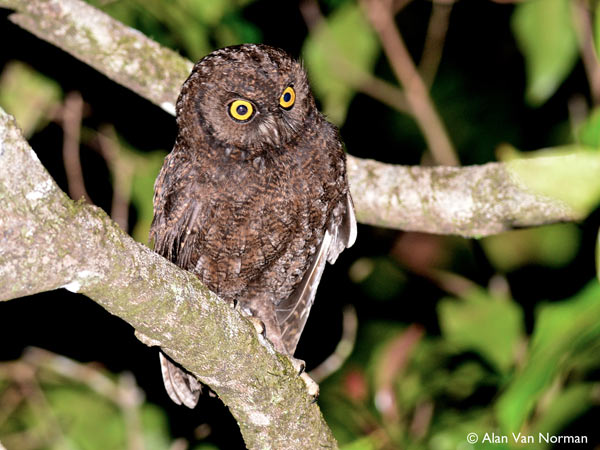 Despite vast forest loss, the Anjouan scops owl is holding on in the Comoros Islands The Anjouan scops owl. Photo by: Alan Van Norman. The Anjouan scops owl—an elusive owl found only on its tiny eponymous island—was once considered among the world’s most endangered owls, and even the most threatened birds. However, the first in-depth […]
Despite vast forest loss, the Anjouan scops owl is holding on in the Comoros Islands The Anjouan scops owl. Photo by: Alan Van Norman. The Anjouan scops owl—an elusive owl found only on its tiny eponymous island—was once considered among the world’s most endangered owls, and even the most threatened birds. However, the first in-depth […]
Destroyed habitat, fewer resources, Ebola: the many repercussions of Liberia’s deforestation
 West African country lost 4.4 percent of forests in 12 years, new incentives may help stymie future destruction Liberia is one of the last strongholds of intact forest in West Africa. These forests are the home of many unique species of plants and animals. They are important for human communities, as well. Many Liberians rely […]
West African country lost 4.4 percent of forests in 12 years, new incentives may help stymie future destruction Liberia is one of the last strongholds of intact forest in West Africa. These forests are the home of many unique species of plants and animals. They are important for human communities, as well. Many Liberians rely […]
Scientists find temperate bat in the hot tropics of the Western Ghats (photos)
 A ground-breaking bat call library is released from one of India’s biodiversity hotspots The Western Ghats is one of the world’s eight richest biodiversity hotspots. A UNESCO World Heritage site, and also known as the Great Escarpment of India, the Ghats run parallel to India’s west coast. This great ecosystem is home to over 139 […]
A ground-breaking bat call library is released from one of India’s biodiversity hotspots The Western Ghats is one of the world’s eight richest biodiversity hotspots. A UNESCO World Heritage site, and also known as the Great Escarpment of India, the Ghats run parallel to India’s west coast. This great ecosystem is home to over 139 […]
A weed by any other name: remnant shrubs and trees play vital role in regenerating forests
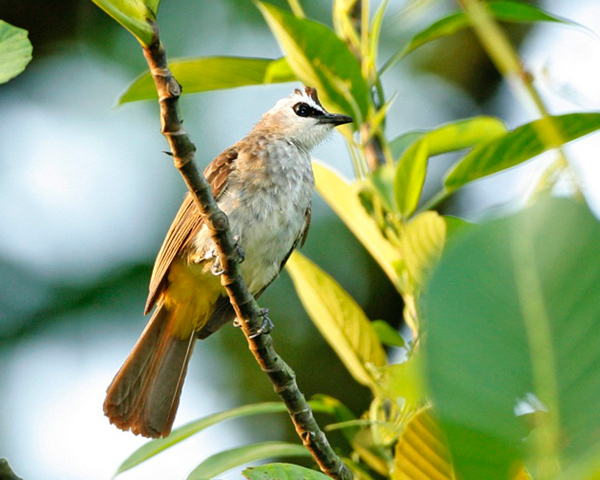 New research in Thailand finds birds and bats key to reforestation efforts Tropical forest restoration projects are exciting research sites for scientists studying factors that affect ecosystem recovery. Here, scientists are trying to understand plant community succession, i.e. the process of recovery after cleared lands are abandoned and allowed to regrow naturally. One of the […]
New research in Thailand finds birds and bats key to reforestation efforts Tropical forest restoration projects are exciting research sites for scientists studying factors that affect ecosystem recovery. Here, scientists are trying to understand plant community succession, i.e. the process of recovery after cleared lands are abandoned and allowed to regrow naturally. One of the […]
Fragmented forests hurt some bat species, may benefit others
 Development of roads and other structures disturb large, continuous patches of habitat for wildlife. This habitat fragmentation is one of the biggest contributors to species extinction, as the local ecology and species interactions are altered. A new study published in mongabay.com’s open-access journal Tropical Conservation Science finds that leaf-nosed bat abundances in Mexico are closely […]
Development of roads and other structures disturb large, continuous patches of habitat for wildlife. This habitat fragmentation is one of the biggest contributors to species extinction, as the local ecology and species interactions are altered. A new study published in mongabay.com’s open-access journal Tropical Conservation Science finds that leaf-nosed bat abundances in Mexico are closely […]
Don’t eat or touch bat bushmeat amid worsening Ebola outbreak, UN warns
 The world’s worst Ebola outbreak was likely begun by a hunter shooting a fruit bat for their dinner or the market, according to the UN. The outbreak has killed over 660 people in six months to date, and recently spread via plane to Nigeria. The disease is particularly deadly with a mortality rate of around […]
The world’s worst Ebola outbreak was likely begun by a hunter shooting a fruit bat for their dinner or the market, according to the UN. The outbreak has killed over 660 people in six months to date, and recently spread via plane to Nigeria. The disease is particularly deadly with a mortality rate of around […]
What’s an environmental journalist to do with so much good news?
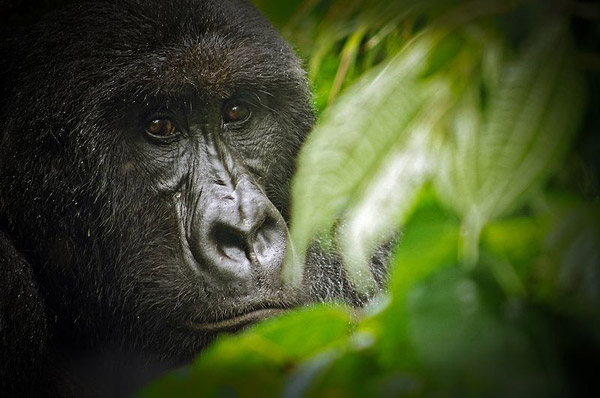 As an environmental journalist covering stories from the great Arctic ice melt to the rhino poaching crisis in Africa, you’ll forgive me if sometimes in the morning—before I turn my computer on—I have a sudden desire to spend a few extra minutes in bed or have a leisurely breakfast with my daughter or just sit […]
As an environmental journalist covering stories from the great Arctic ice melt to the rhino poaching crisis in Africa, you’ll forgive me if sometimes in the morning—before I turn my computer on—I have a sudden desire to spend a few extra minutes in bed or have a leisurely breakfast with my daughter or just sit […]
PhD students ‘thrilled’ to rediscover mammal missing for 124 years
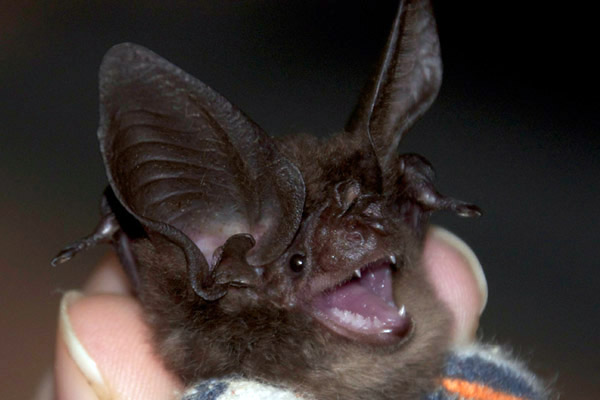 In 1890 Lamberto Loria collected 45 specimens—all female—of a small bat from the wilds of Papua New Guinea. Nearly 25 years later, in 1914, the species was finally described and named by British zoologist Oldfield Thomas, who dubbed it the New Guinea big-eared bat (Pharotis imogene) after its massive ears. But no one ever saw […]
In 1890 Lamberto Loria collected 45 specimens—all female—of a small bat from the wilds of Papua New Guinea. Nearly 25 years later, in 1914, the species was finally described and named by British zoologist Oldfield Thomas, who dubbed it the New Guinea big-eared bat (Pharotis imogene) after its massive ears. But no one ever saw […]
Acoustic surveying: new monitoring technique beats bats at their own game
 Species monitoring can be a very invasive form of research. For instance, bird-banding – in which identification bands are placed around birds’ legs to track their movements – usually requires first catching them in nets. However, the use of non-invasive techniques made possible through advancements in technology has been on the rise. A new study […]
Species monitoring can be a very invasive form of research. For instance, bird-banding – in which identification bands are placed around birds’ legs to track their movements – usually requires first catching them in nets. However, the use of non-invasive techniques made possible through advancements in technology has been on the rise. A new study […]
The matrix matters: scientists find surprising biodiversity between forests
 The Theory of Island Biogeography, coined by Robert MacArthur and E.O. Wilson, helps describe why species are distributed as they are. The larger and closer an island is to another (or to the mainland), the more biodiverse it should be. This can be used to describe actual islands in the ocean, like the Galapagos, or […]
The Theory of Island Biogeography, coined by Robert MacArthur and E.O. Wilson, helps describe why species are distributed as they are. The larger and closer an island is to another (or to the mainland), the more biodiverse it should be. This can be used to describe actual islands in the ocean, like the Galapagos, or […]
Scientists discover giant sperm fossilized in bat feces (PHOTOS)
 In a cave in Australia, researchers from the University of New South Wales discovered giant fossilized sperm. The sperm were produced 17 million years ago by a group of tiny, shelled crustaceans called ostracods, making them the oldest fossilized sperm ever found. The results were published recently in Proceedings of the Royal Society B. The […]
In a cave in Australia, researchers from the University of New South Wales discovered giant fossilized sperm. The sperm were produced 17 million years ago by a group of tiny, shelled crustaceans called ostracods, making them the oldest fossilized sperm ever found. The results were published recently in Proceedings of the Royal Society B. The […]
The remarkable story of how a bat scientist took on Russia’s most powerful…and won
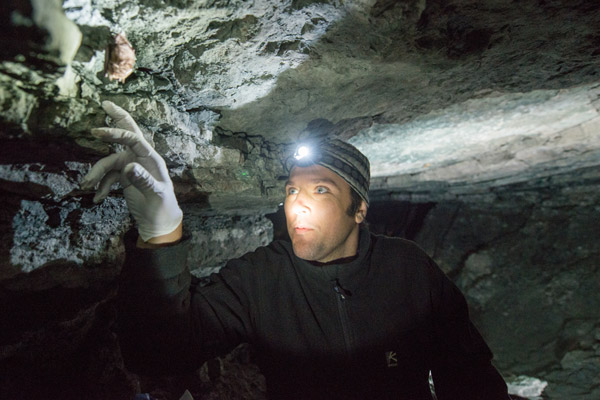 Suren Gazaryan. Photo by: Goldman Environmental Prize. In a country increasingly known for its authoritarian-style crackdown on activists and dissidents, a bat scientist has won a number of impressive victories to protect the dwindling forests of the Western Caucasus. Beginning in the 1990s, Russian chiropterologist Suren Gazaryan led a number of campaigns to fight illegal […]
Suren Gazaryan. Photo by: Goldman Environmental Prize. In a country increasingly known for its authoritarian-style crackdown on activists and dissidents, a bat scientist has won a number of impressive victories to protect the dwindling forests of the Western Caucasus. Beginning in the 1990s, Russian chiropterologist Suren Gazaryan led a number of campaigns to fight illegal […]
City lights threaten rainforests by deterring bats
 Fruit-eating bats play an important role in forest regeneration, collecting and spreading seeds far and wide. However, human development may be stymying bat-mediated dispersal. In a new study published in the British Ecological Society’s Journal of Applied Ecology, researchers found that fruit bats avoid feeding in light-polluted areas, which may significantly affect forest growth. Scientists […]
Fruit-eating bats play an important role in forest regeneration, collecting and spreading seeds far and wide. However, human development may be stymying bat-mediated dispersal. In a new study published in the British Ecological Society’s Journal of Applied Ecology, researchers found that fruit bats avoid feeding in light-polluted areas, which may significantly affect forest growth. Scientists […]
New bat species discovered in Brazil leaves another at risk
 A team of researchers has discovered a new species of bat in Brazil, which has put a previously known species, Bokermann’s nectar bat (Lonchophylla bokermanni), at risk of extinction. Long thought to comprise one species, the bat populations of the Atlantic Forest and the Cerrado – the tropical savannah of Brazil’s interior – are in […]
A team of researchers has discovered a new species of bat in Brazil, which has put a previously known species, Bokermann’s nectar bat (Lonchophylla bokermanni), at risk of extinction. Long thought to comprise one species, the bat populations of the Atlantic Forest and the Cerrado – the tropical savannah of Brazil’s interior – are in […]
Five new, cryptic bats discovered in Senegal
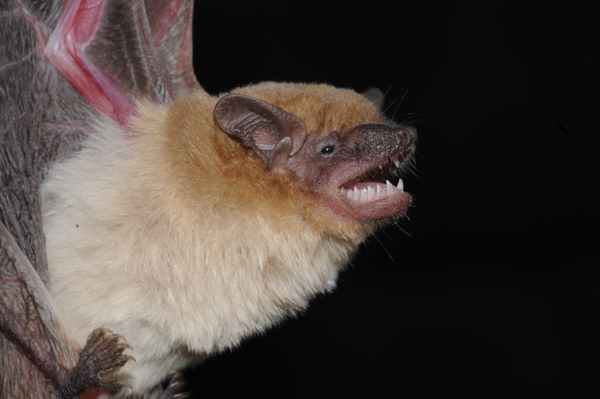 An international research team led by Professor Petr Koube and Darina Koubínová has discovered five new species of vesper bats during a series of expeditions to Senegal’s Niokolo-Koba National Park. The new species are considered cryptic, because their genetic makeup is different despite physical similarities. The new bats have yet to be named. This was […]
An international research team led by Professor Petr Koube and Darina Koubínová has discovered five new species of vesper bats during a series of expeditions to Senegal’s Niokolo-Koba National Park. The new species are considered cryptic, because their genetic makeup is different despite physical similarities. The new bats have yet to be named. This was […]
Dolphins, bats and the evolution of echolocation
 A dolphin swimming through the world’s oceans after fish, and a bat flying through the air with its membranous wings to catch insects or eat fruit: at first glance, it looks like no two creatures could be more different. But it turns out they share a superpower – they hunt prey by emitting high-pitched sounds […]
A dolphin swimming through the world’s oceans after fish, and a bat flying through the air with its membranous wings to catch insects or eat fruit: at first glance, it looks like no two creatures could be more different. But it turns out they share a superpower – they hunt prey by emitting high-pitched sounds […]
First study of little-known mammal reveals climate change threat
 One of the world’s least-known flying foxes could face extinction by rising seas and changing precipitation patterns due to global warming, according to a new study in Zookeys. The research, headed by Donald Buden with the College of Micronesia, is the first in-depth study of the resident bats of the remote Mortlock Islands, a part […]
One of the world’s least-known flying foxes could face extinction by rising seas and changing precipitation patterns due to global warming, according to a new study in Zookeys. The research, headed by Donald Buden with the College of Micronesia, is the first in-depth study of the resident bats of the remote Mortlock Islands, a part […]
Bat’s tongue could inspire miniature surgical robot design
 Nectar-feeding bats shift the shape of their tongue to slurp up sugar from flowers upon which they feed, finds a new study published in the Proceedings of the National Academy of Sciences. Using histological techniques, high-speed videography, and anatomical studies, Brown University biologist Cally Harper and colleagues found that the bat Glossophaga soricina relies on […]
Nectar-feeding bats shift the shape of their tongue to slurp up sugar from flowers upon which they feed, finds a new study published in the Proceedings of the National Academy of Sciences. Using histological techniques, high-speed videography, and anatomical studies, Brown University biologist Cally Harper and colleagues found that the bat Glossophaga soricina relies on […]
Beautiful striped bat is the “find of a lifetime” (photos)
 Scientists have uncovered a rare, brilliantly-striped bat in South Sudan that has yielded new secrets after close study. Working in Bangangai Game Reserve during July of last year, biologist DeeAnn Redeer and conservationist Adrian Garsdie with Fauna & Flora International (FFI) came across an unmissable bat, which has been dubbed by various media outlets as […]
Scientists have uncovered a rare, brilliantly-striped bat in South Sudan that has yielded new secrets after close study. Working in Bangangai Game Reserve during July of last year, biologist DeeAnn Redeer and conservationist Adrian Garsdie with Fauna & Flora International (FFI) came across an unmissable bat, which has been dubbed by various media outlets as […]
Bats face new perils from climate change
 A change in prey abundance due to climate change could impact the lesser mouse-eared bat (Myotis blythii). Photo by: Christoph F. Robiller. Global climate change could devastate bat populations around the world, threatening to tear yet another thread from the tapestry of biodiversity should current temperature trends persist, according to a new study. “Bats were […]
A change in prey abundance due to climate change could impact the lesser mouse-eared bat (Myotis blythii). Photo by: Christoph F. Robiller. Global climate change could devastate bat populations around the world, threatening to tear yet another thread from the tapestry of biodiversity should current temperature trends persist, according to a new study. “Bats were […]
Photos: emperor penguins take first place in renowned wildlife photo contest
-Bubble-jetting-emperors-.568.jpg) This was the image Paul had been so hoping to get: a sunlit mass of emperor penguins charging upwards, leaving in their wake a crisscross of bubble trails. The location was near the emperor colony at the edge of the frozen area of the Ross Sea, Antarctica. It was into the only likely exit hole […]
This was the image Paul had been so hoping to get: a sunlit mass of emperor penguins charging upwards, leaving in their wake a crisscross of bubble trails. The location was near the emperor colony at the edge of the frozen area of the Ross Sea, Antarctica. It was into the only likely exit hole […]
Endangered fruit bats, and many other species, on the menu in the Philippines
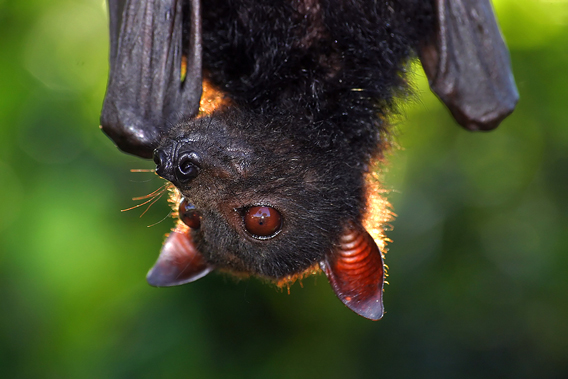 Pteropus vampyrus hanging in tree in Sierra Madre Natural Park, Philippines. Photo by: Bigstock. Bushmeat hunting is well-known to be decimating animal populations in Africa, but has been little studied much of Southeast Asia. However, a new paper in mongabay.com’s open access journal Tropical Conservation Science shines light on the size and scale of bushmeat […]
Pteropus vampyrus hanging in tree in Sierra Madre Natural Park, Philippines. Photo by: Bigstock. Bushmeat hunting is well-known to be decimating animal populations in Africa, but has been little studied much of Southeast Asia. However, a new paper in mongabay.com’s open access journal Tropical Conservation Science shines light on the size and scale of bushmeat […]
Less than 100 pygmy sloths survive
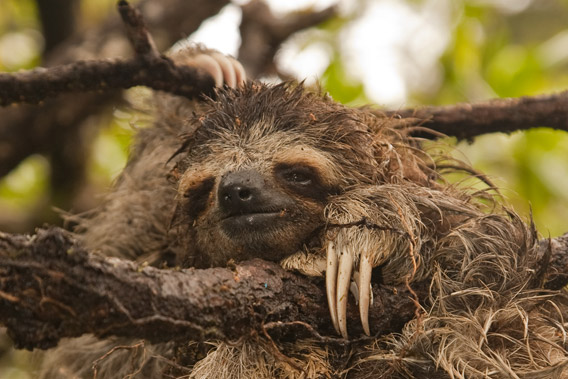 The three-toed pygmy sloth. Photo © Craig Turner/ZSL. The pygmy three-toed sloth (Bradypus pygmaeus) is one of the world’s most endangered mammals, according to a detailed survey of the population, which found less than 100 sloths hanging on in their island home. Only described by researchers in 2001, the pygmy sloth lives on a single […]
The three-toed pygmy sloth. Photo © Craig Turner/ZSL. The pygmy three-toed sloth (Bradypus pygmaeus) is one of the world’s most endangered mammals, according to a detailed survey of the population, which found less than 100 sloths hanging on in their island home. Only described by researchers in 2001, the pygmy sloth lives on a single […]
Island bat goes extinct after Australian officials hesitate
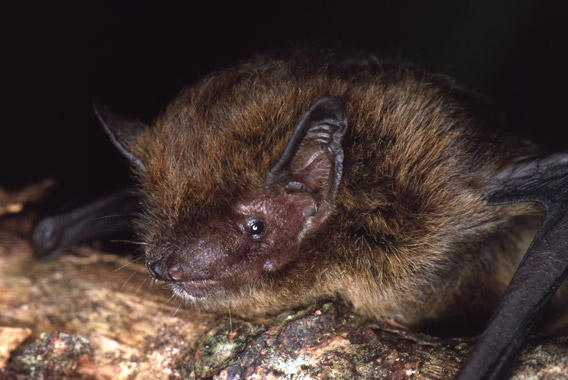 Now extinct: the Christmas Island pipistrelle. Photo by: Lindy Lumsden. Nights on Christmas Island in the Indian Ocean will never again be the same. The last echolocation call of a tiny bat native to the island, the Christmas Island pipistrelle (Pipistrellus murrayi), was recorded on August 26th 2009, and since then there has been only […]
Now extinct: the Christmas Island pipistrelle. Photo by: Lindy Lumsden. Nights on Christmas Island in the Indian Ocean will never again be the same. The last echolocation call of a tiny bat native to the island, the Christmas Island pipistrelle (Pipistrellus murrayi), was recorded on August 26th 2009, and since then there has been only […]
Animal picture of the day: Indian flying foxes soar
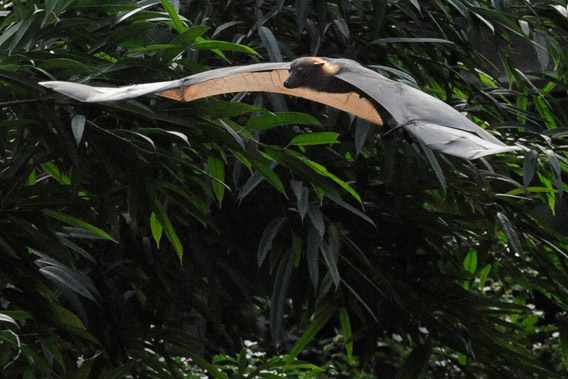 Indian flying fox soaring at the WCS Bronx Zoo. Photo by: Julie Larsen Maher/WCS. Indian flying foxes (Pteropus giganteus) are now soaring a the Wildlife Conservation Society’s (WCS) Bronx Zoo. With wingspans that reach 4 to 5 feet (1.2-1.5 meters), they are one of the world’s largest bats. “Bats are a vital part of the […]
Indian flying fox soaring at the WCS Bronx Zoo. Photo by: Julie Larsen Maher/WCS. Indian flying foxes (Pteropus giganteus) are now soaring a the Wildlife Conservation Society’s (WCS) Bronx Zoo. With wingspans that reach 4 to 5 feet (1.2-1.5 meters), they are one of the world’s largest bats. “Bats are a vital part of the […]
Disease kills 6 million bats in North America
.360.jpg) In just six years around six million bats have succumbed to white-nose syndrome in North America, according to U.S. federal researchers. The number, somewhere between 5.7 and 6.7 million bats, is far higher than past estimates of over a million. Showing up in 2006 in New York, the perplexing disease, which appears as white dust […]
In just six years around six million bats have succumbed to white-nose syndrome in North America, according to U.S. federal researchers. The number, somewhere between 5.7 and 6.7 million bats, is far higher than past estimates of over a million. Showing up in 2006 in New York, the perplexing disease, which appears as white dust […]
Bat-killing culprit identified by scientists
.360.jpg) First identified in 2005, white-nose syndrome has killed over a million bats in the US, pushing once common species to the edge of collapse and imperiling already-endangered species. Striking when bats hibernate, the disease leaves a white dust on the bat’s muzzle, causing them to starve to death. Long believed to be caused by a […]
First identified in 2005, white-nose syndrome has killed over a million bats in the US, pushing once common species to the edge of collapse and imperiling already-endangered species. Striking when bats hibernate, the disease leaves a white dust on the bat’s muzzle, causing them to starve to death. Long believed to be caused by a […]
Photos: Halloween creepy-crawlies of the natural world
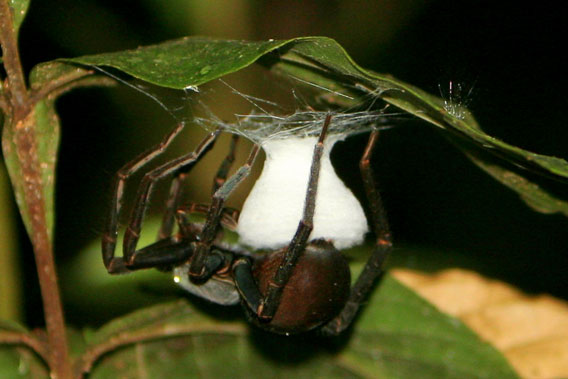 Everyone loves the beautiful animals, the playful orangutans, the rolly-polly pandas, the regal tigers, the wise elephants, the awe-inspiring whales, the silly penguins—and it shows. Aside from gracing calendars and starring in movies, these species receive millions in conservation funds and have no shortage of researchers devoted to them. But what about the ugly, crawly, […]
Everyone loves the beautiful animals, the playful orangutans, the rolly-polly pandas, the regal tigers, the wise elephants, the awe-inspiring whales, the silly penguins—and it shows. Aside from gracing calendars and starring in movies, these species receive millions in conservation funds and have no shortage of researchers devoted to them. But what about the ugly, crawly, […]
Photos: three bizarre bats discovered in Southeast Asia
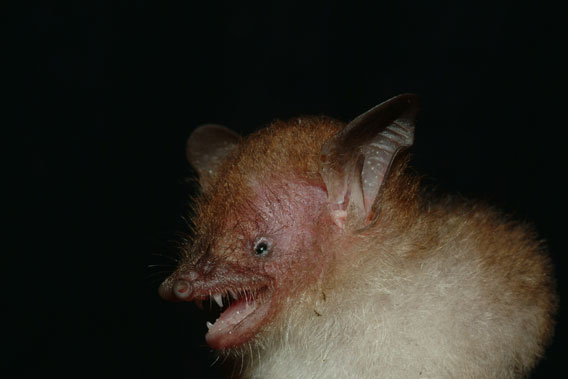 Murina walstoni, a new bat species named after Joe Walston, Wildlife Conservation Society’s (WCS) Executive Director for Asia Programs. Photo by: Gabor Csorba. In the forests of Cambodia and Vietnam, researchers have discovered three new species of tube-nosed bats, known for extraordinary nostrils that look like blooming flowers. The new bats, described in the Journal […]
Murina walstoni, a new bat species named after Joe Walston, Wildlife Conservation Society’s (WCS) Executive Director for Asia Programs. Photo by: Gabor Csorba. In the forests of Cambodia and Vietnam, researchers have discovered three new species of tube-nosed bats, known for extraordinary nostrils that look like blooming flowers. The new bats, described in the Journal […]
How to monitor biodiversity for REDD projects
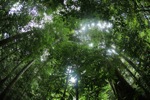 Although the international program Reduced Emissions from Deforestation and Degradation (REDD) was developed in order to lower greenhouse gas emissions by protecting standing forests, conservationists have long pointed out that another result from a well-crafted REDD program could be to conserve biodiversity. But one of the difficulties of including biodiversity is how to measure the […]
Although the international program Reduced Emissions from Deforestation and Degradation (REDD) was developed in order to lower greenhouse gas emissions by protecting standing forests, conservationists have long pointed out that another result from a well-crafted REDD program could be to conserve biodiversity. But one of the difficulties of including biodiversity is how to measure the […]
New ‘demon’ bat discovered in Vietnam (PHOTO)
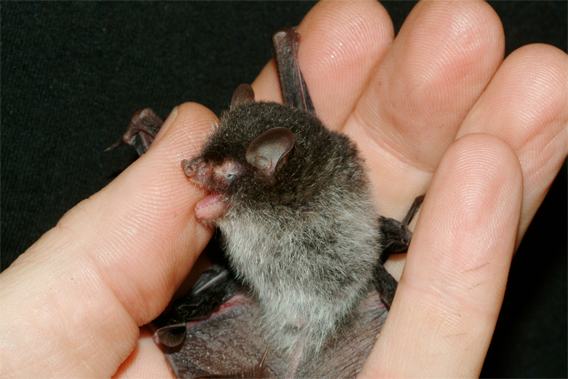 Murina beelzebub © Gabor Csorba/HNHM. Scientists have discovered three previously unknown bat species in southern Indochina, reports Fauna & Flora International. Researchers from Hungarian Natural History Museum (HNHM) and Fauna & Flora International (FFI) described the new species, which belong to a group known as tube-nosed bats. One of the species, found in Vietnam and […]
Murina beelzebub © Gabor Csorba/HNHM. Scientists have discovered three previously unknown bat species in southern Indochina, reports Fauna & Flora International. Researchers from Hungarian Natural History Museum (HNHM) and Fauna & Flora International (FFI) described the new species, which belong to a group known as tube-nosed bats. One of the species, found in Vietnam and […]
Photos: new bat uncovered in the Caribbean
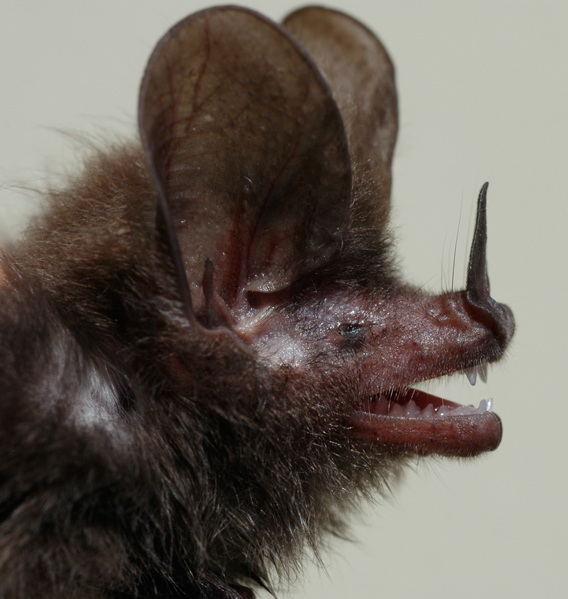 New bat species from St. Vincent has been named Garifuna bat. Photo by: Peter A. Larsen. Researchers have declared a new species of bat from the Caribbean island of St. Vincent. While the new bat had been documented before, it was long believed to be a member of a similar species that is found throughout […]
New bat species from St. Vincent has been named Garifuna bat. Photo by: Peter A. Larsen. Researchers have declared a new species of bat from the Caribbean island of St. Vincent. While the new bat had been documented before, it was long believed to be a member of a similar species that is found throughout […]
Bats worth billions
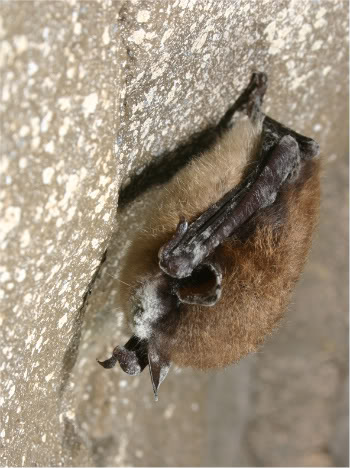 US agriculture stands to lose billions in free ecosystem services from the often-feared and rarely respected humble bat. According to a recent study in Science bats in North America provide the US agricultural industry at least $3.7 billion and up to a staggering $53 billion a year by eating mounds of potentially pesky insects. Yet […]
US agriculture stands to lose billions in free ecosystem services from the often-feared and rarely respected humble bat. According to a recent study in Science bats in North America provide the US agricultural industry at least $3.7 billion and up to a staggering $53 billion a year by eating mounds of potentially pesky insects. Yet […]
Tiny bats trade in caves for pitcher plants in Borneo
 A tiny species of bat in Borneo has chosen an unusual roost: a carnivorous pitcher plant, according to a recent study. The study examines how this behavior actually benefits both the bats and the plants, creating a symbiotic relationship. In the Biology Letters‘s study, Hardwicke’s woolly bats (Kerivoula hardwickii) were found to consistently roost in […]
A tiny species of bat in Borneo has chosen an unusual roost: a carnivorous pitcher plant, according to a recent study. The study examines how this behavior actually benefits both the bats and the plants, creating a symbiotic relationship. In the Biology Letters‘s study, Hardwicke’s woolly bats (Kerivoula hardwickii) were found to consistently roost in […]
Photos: wild, weird, and rare mammals storm the conservation world
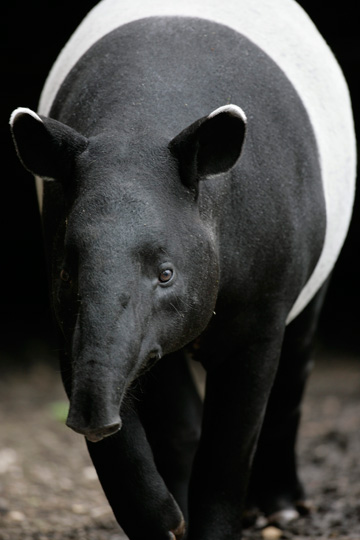 The conservation program, EDGE, takes a second look at the world’s unique and threatened mammals. What do the New Zealand greater short-tailed bat, the black-and-white ruffed lemur, and the numbat have in common? They are all new members of the Zoological Society of London’s EDGE’s top 100 most endangered and unique mammals list. Arguably the […]
The conservation program, EDGE, takes a second look at the world’s unique and threatened mammals. What do the New Zealand greater short-tailed bat, the black-and-white ruffed lemur, and the numbat have in common? They are all new members of the Zoological Society of London’s EDGE’s top 100 most endangered and unique mammals list. Arguably the […]
New bat species confirmed in Ecuador, may already be extinct
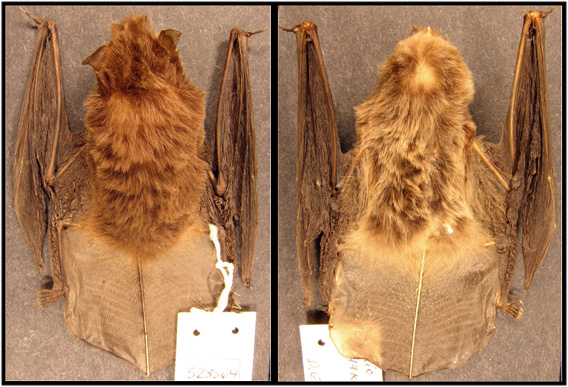 Although the first specimen was collected over 30 years ago, scientists have only now confirmed that a tiny brown bat is indeed a unique species. Named Myotis diminutus for its incredibly small size, the new bat was discovered in the Chocó biodiversity hotspot, amid the moist forests of western Ecuador. “There are more than one […]
Although the first specimen was collected over 30 years ago, scientists have only now confirmed that a tiny brown bat is indeed a unique species. Named Myotis diminutus for its incredibly small size, the new bat was discovered in the Chocó biodiversity hotspot, amid the moist forests of western Ecuador. “There are more than one […]
Photos: surprises discovered in tiny forest fragment surrounded by palm oil
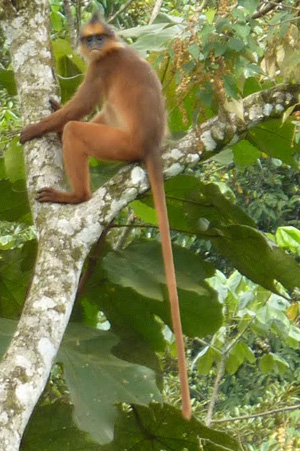 Researchers have uncovered an astounding number of species in a tiny protected forest fragment surrounded on all side by palm oil plantations in the Indonesian island of Sumatra. Researchers with the Zoological Society of London (ZSL), Queen Mary, University of London and the Durrell Institute of Conservation and Ecology (DICE – University of Kent) recorded […]
Researchers have uncovered an astounding number of species in a tiny protected forest fragment surrounded on all side by palm oil plantations in the Indonesian island of Sumatra. Researchers with the Zoological Society of London (ZSL), Queen Mary, University of London and the Durrell Institute of Conservation and Ecology (DICE – University of Kent) recorded […]
How the overlooked peccary engineers the Amazon, an interview with Harald Beck
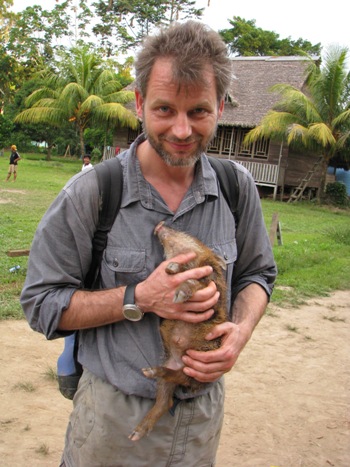 When people think of the Amazon rainforest, they likely think of roaring jaguars, jumping monkeys, marching ants, and squeezing anacondas. The humble peccary would hardly be among the first animals to cross their mind, if they even know such pig-like animals exists! Yet new research on the peccary is proving just how vital these species […]
When people think of the Amazon rainforest, they likely think of roaring jaguars, jumping monkeys, marching ants, and squeezing anacondas. The humble peccary would hardly be among the first animals to cross their mind, if they even know such pig-like animals exists! Yet new research on the peccary is proving just how vital these species […]
Exploring Kenya’s sky island
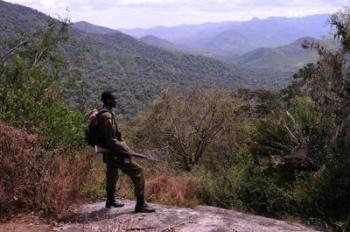 An interview with Paula Kahumbu of WildlifeDirect. Rising over 2,500 meters from Kenya’s northern desert, the Mathews Range is a sky island: isolated mountain forests surrounded by valleys. Long cut off from other forests, ‘sky islands’ such as this often contain unique species and ecosystems. Supported by the Nature Conservancy, an expedition including local community […]
An interview with Paula Kahumbu of WildlifeDirect. Rising over 2,500 meters from Kenya’s northern desert, the Mathews Range is a sky island: isolated mountain forests surrounded by valleys. Long cut off from other forests, ‘sky islands’ such as this often contain unique species and ecosystems. Supported by the Nature Conservancy, an expedition including local community […]
Diverse habitats needed for survival of small mammals in Mexico
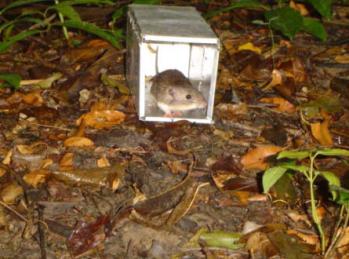 A new study in Tropical Conservation Science shows that small tropical mammals in Mexico—bats and rodents—require a variety of habitats to thrive. Surveying mammal populations in the Isthmus of Tehuantepec, Oaxaca, Mexico, researchers found that sites comprising the greatest habitat diversity carried also the greatest diversity of rodents. In turn bats lived in all variety […]
A new study in Tropical Conservation Science shows that small tropical mammals in Mexico—bats and rodents—require a variety of habitats to thrive. Surveying mammal populations in the Isthmus of Tehuantepec, Oaxaca, Mexico, researchers found that sites comprising the greatest habitat diversity carried also the greatest diversity of rodents. In turn bats lived in all variety […]
Why seed dispersers matter, an interview with Pierre-Michel Forget, chair of the FSD International Symposium
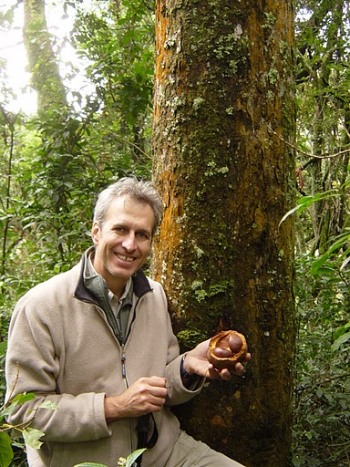 The first in an interview series with participants in the 5th Frugivore and Seed Dispersal International Symposium. There are few areas of research in tropical biology more exciting and more important than seed dispersal. Seed dispersal—the process by which seeds are spread from parent trees to new sprouting ground—underpins the ecology of forests worldwide. In […]
The first in an interview series with participants in the 5th Frugivore and Seed Dispersal International Symposium. There are few areas of research in tropical biology more exciting and more important than seed dispersal. Seed dispersal—the process by which seeds are spread from parent trees to new sprouting ground—underpins the ecology of forests worldwide. In […]
Photos: park in Ecuador likely contains world’s highest biodiversity, but threatened by oil
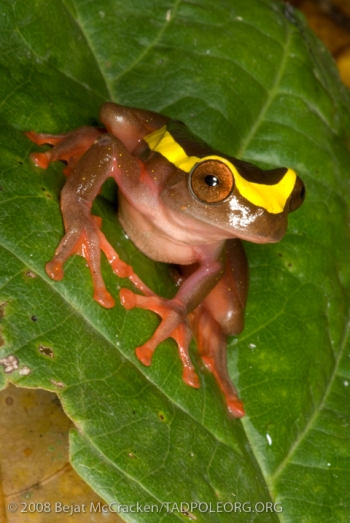 In the midst of a seesaw political battle to save Yasuni National Park from oil developers, scientists have announced that this park in Ecuador houses more species than anywhere else in South America—and maybe the world. “Yasuní is at the center of a small zone where South America’s amphibians, birds, mammals, and vascular plants all […]
In the midst of a seesaw political battle to save Yasuni National Park from oil developers, scientists have announced that this park in Ecuador houses more species than anywhere else in South America—and maybe the world. “Yasuní is at the center of a small zone where South America’s amphibians, birds, mammals, and vascular plants all […]
Hunting across Southeast Asia weakens forests’ survival, An interview with Richard Corlett
 Seventh in a series of interviews with participants at the 2009 Association of Tropical Biology and Conservation (ATBC) conference. A large flying fox eats a fruit ingesting its seeds. Flying over the tropical forests it eventually deposits the seeds at the base of another tree far from the first. One of these seeds takes root, […]
Seventh in a series of interviews with participants at the 2009 Association of Tropical Biology and Conservation (ATBC) conference. A large flying fox eats a fruit ingesting its seeds. Flying over the tropical forests it eventually deposits the seeds at the base of another tree far from the first. One of these seeds takes root, […]
Scientists discover that bats practice oral sex
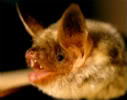 The short-nosed fruit bat Cynopterus sphinx is the first bat species to have been observed engaging in oral sex. New research headed by Min Tan of China’s Guangdong Entomological Institute discovered that female short nosed fruit bats would often lick the shaft of the male bats’ penis during penetration. Before this discovery published in PLoS […]
The short-nosed fruit bat Cynopterus sphinx is the first bat species to have been observed engaging in oral sex. New research headed by Min Tan of China’s Guangdong Entomological Institute discovered that female short nosed fruit bats would often lick the shaft of the male bats’ penis during penetration. Before this discovery published in PLoS […]
New reserve created in Cambodia with REDD in mind
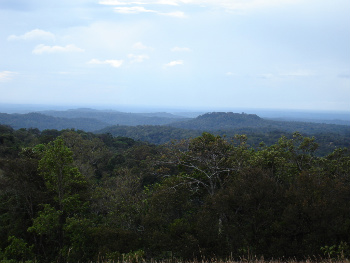 Cambodia’s Royal Government’s Council of Ministers has declared the creation of the Seima Protection Forest, a 1,100 square miles (2,849 square kilometers) park home to tigers, elephants, and endangered primates. The park’s creation was developed in part by the Wildlife Conservation Society’s (WCS) “Carbon for Conservation” program, which intends to protect high-biodiversity ecosystems while raising […]
Cambodia’s Royal Government’s Council of Ministers has declared the creation of the Seima Protection Forest, a 1,100 square miles (2,849 square kilometers) park home to tigers, elephants, and endangered primates. The park’s creation was developed in part by the Wildlife Conservation Society’s (WCS) “Carbon for Conservation” program, which intends to protect high-biodiversity ecosystems while raising […]
Hunger drives great tits to kill and eat bats as they hibernate
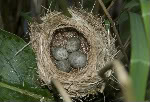 A common bird in Europe, the great tit tends to stick to insects and seeds as a food source with caterpillars as a particular favorite. However, a new paper in Biology Letters found that the song bird employs unique feeding behavior in a cave in Hungary: they kill and eat hibernating pipistrelle bats. This is […]
A common bird in Europe, the great tit tends to stick to insects and seeds as a food source with caterpillars as a particular favorite. However, a new paper in Biology Letters found that the song bird employs unique feeding behavior in a cave in Hungary: they kill and eat hibernating pipistrelle bats. This is […]
New species everywhere in Papua New Guinea’s ‘lost’ volcano
 A five week expedition into a remote extinct volcano has uncovered a treasure trove of new species in Papua New Guinea, including what may be the world’s largest rat, a fanged frog, and a grunting fish. In all the expedition estimates it may have found around forty species unknown to science. The expedition was undertaken […]
A five week expedition into a remote extinct volcano has uncovered a treasure trove of new species in Papua New Guinea, including what may be the world’s largest rat, a fanged frog, and a grunting fish. In all the expedition estimates it may have found around forty species unknown to science. The expedition was undertaken […]
World’s largest bat threatened with extinction due to legal hunting
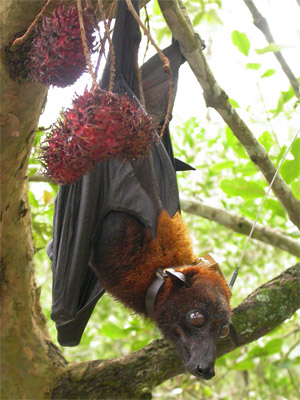
Moths defend against bats by ‘jamming’ sonar
Researchers have discovered that a species of tiger moth eludes bats by jamming their echolocation with ultrasonic clicks. The discovery, published in the journal Science, adds to the list of defensive mechanisms that insects use to defend themselves against bats. Aaron Corcoran and colleagues used ultrasonic recording and high-speed infrared video to determine that the […]
Tiny bat discovered on islands off Africa
The Natural History Museum in Geneva, Switzerland has announced the discovery of a bat species new to science on the Comoros Island arichpelago off the south-east coast of Africa. The bat weighs only 5 grams (0.17 ounces). The new bat from Comoros has been named Miniopterus aelleni, honoring the late Villy Aellen, former head of […]
In the dark, bats identify each other by voice
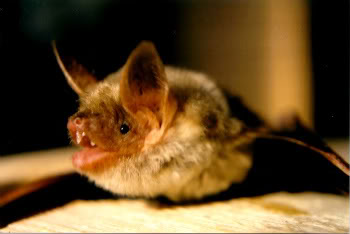 Individual bats have the ability to tell the difference between other bats just by the sound of their voice, according to a study published in PLoS Computational Biology. Researchers from the University of Tuebingen, Germany found that the greater mouse-eared bat could distinguish between their fellows’ echolocation calls. A subject bat was tested by having […]
Individual bats have the ability to tell the difference between other bats just by the sound of their voice, according to a study published in PLoS Computational Biology. Researchers from the University of Tuebingen, Germany found that the greater mouse-eared bat could distinguish between their fellows’ echolocation calls. A subject bat was tested by having […]
Extinction of Christmas Island Pipistrelle bat predicted in less than six months
The Australasian Bat Society predicts that the Christmas Island Pipistrelle bat has less than six months left until extinction, unless measures are taken immediately to set-up a captive breeding population. Found only on Christmas Island in the Indian Ocean—an Australian territory—the Christmas Island Pipistrelle bat was first labelled as Critically Endangered by the Environment Protection […]
‘Stopgap’ to preserve US bats from devastating fungus

Shade-grown coffee preserves native tree diversity
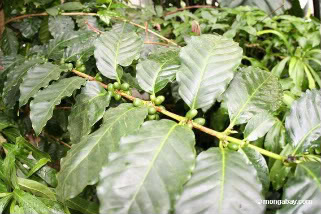 Shade-grown coffee protects more than birds and bats
Shade-grown coffee protects more than birds and bats
Limestone karsts – islands of biodiversity in Asia – under threat from mining
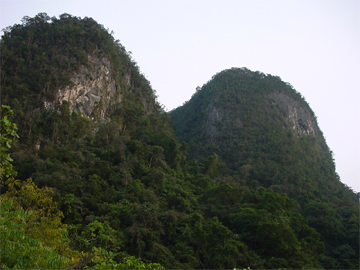 Limestone karsts – islands of biodiversity in Asia – under threat from mining Limestone karsts – islands of biodiversity in Asia – under threat from mining mongabay.com November 10, 2008
Limestone karsts – islands of biodiversity in Asia – under threat from mining Limestone karsts – islands of biodiversity in Asia – under threat from mining mongabay.com November 10, 2008
Massive bat species returns from the brink of extinction
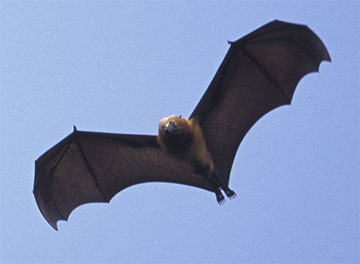 Massive bat species returns from the brink of extinction Massive bat species returns from the brink of extinction mongabay.com October 31, 2008
Massive bat species returns from the brink of extinction Massive bat species returns from the brink of extinction mongabay.com October 31, 2008
Previously unknown fungus may have triggered mass bat die-offs in the U.S.
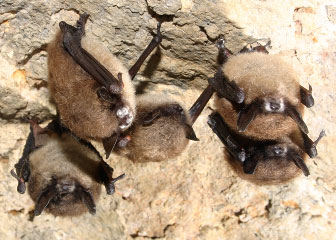 Researchers have identified the fungus that may have been the culprit in mass die-offs of bats in the northeastern United States during the winter of 2006-2007. The research is published in this week’s issue of Science. During the outbreak, which killed 100,000 hibernating bats, many bats were afflicted with “white-nose” syndrome — a white, powdery-looking […]
Researchers have identified the fungus that may have been the culprit in mass die-offs of bats in the northeastern United States during the winter of 2006-2007. The research is published in this week’s issue of Science. During the outbreak, which killed 100,000 hibernating bats, many bats were afflicted with “white-nose” syndrome — a white, powdery-looking […]
How do wind turbines kill bats?
Researchers discover why wind turbines are hazardous to bats How do wind turbines kill bats? Jeremy Hance, mongabay.com August 25, 2008 Drop in air pressure, not collisions, devastate bat populations that fly by wind turbines Numerous studies have shown that migratory bats are undergoing large fatalities due to wind turbines. Far more bats die due […]
Critically endangered fruit bat born in New York City
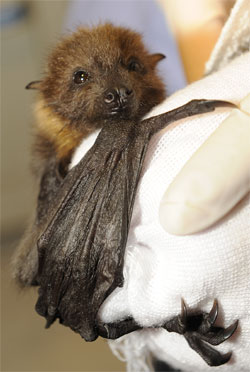 Photo: Critically endangered fruit bat born in New York City Critically endangered fruit bat born in New York City mongabay.com August 1, 2008 A critically endangered fruit bat was born last month at the Bronx Zoo. The female Rodriguez fruit bat was born July 6 and has been named “Buffy” by staff Veterinarians at the […]
Photo: Critically endangered fruit bat born in New York City Critically endangered fruit bat born in New York City mongabay.com August 1, 2008 A critically endangered fruit bat was born last month at the Bronx Zoo. The female Rodriguez fruit bat was born July 6 and has been named “Buffy” by staff Veterinarians at the […]
Fruit bats frequent clay-licks in the Amazon rainforest
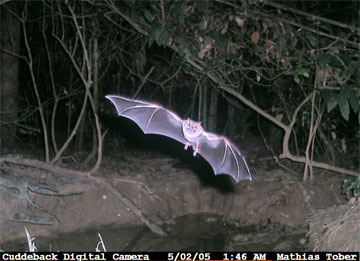 Fruit bats frequent clay-licks in the Amazon rainforest Fruit bats frequent clay-licks in the Amazon rainforest Jeremy Hance, mongabay.com July 14, 2008 In the Peru new research finds that female fruit bats are frequent visitors to clay-licks Clay-licks, or collpas as they are called in Peru, are visited by a wide assortment of animals, including […]
Fruit bats frequent clay-licks in the Amazon rainforest Fruit bats frequent clay-licks in the Amazon rainforest Jeremy Hance, mongabay.com July 14, 2008 In the Peru new research finds that female fruit bats are frequent visitors to clay-licks Clay-licks, or collpas as they are called in Peru, are visited by a wide assortment of animals, including […]
Rainforest recovery after deforestation can be enhanced by artificial bat houses
“Bat boxes” could help in the recovery of tropical rainforest after deforestation, reports research described in New Scientist Magazine. Placing artificial bat roosts in deforested areas in Costa Rica, Detlev Kelm at the Leibniz Institute for Zoo and Wildlife Research in Berlin, Germany, and colleagues found that 5-20 times as many seeds were deposited around […]
Fruit-eating bats ingest dirt to counter toxic plant compounds
Pregnant and lactating frugivorous bats ingest dirt in order to detoxify plant compounds in the fruit they eat, report researchers writing in the journal PLoS ONE. Capturing female bats at mineral licks in the Amazonian rainforest of Ecuador, researchers led by Dr. Christian Voigt of the Berlin Leibniz Institute for Zoo and Wildlife Research found […]
Bats protect crops from insects
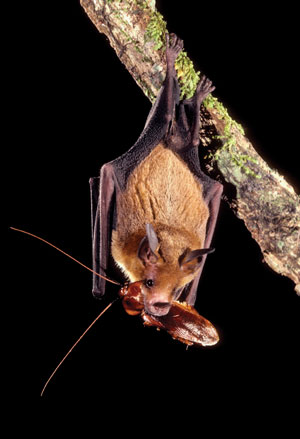 Bats significantly reduce insect damage to plants, report researchers from the Smithsonian Tropical Research Institute and the University of Michigan. Using nets to control the presence of bats and birds at certain times of the day in a Panamanian rainforest and a Mexican coffee plantation, the scientists found that bats can be more effective pest […]
Bats significantly reduce insect damage to plants, report researchers from the Smithsonian Tropical Research Institute and the University of Michigan. Using nets to control the presence of bats and birds at certain times of the day in a Panamanian rainforest and a Mexican coffee plantation, the scientists found that bats can be more effective pest […]
Bats eat as many insects as birds
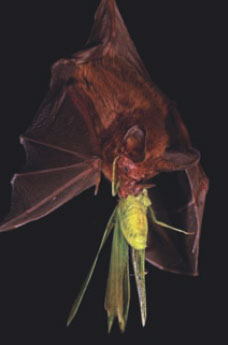 Bats eat as many insects at night as birds do during the day, according to research published in the journal Science. Using nets to control the presence of bats and birds at certain times of the day in the Panamanian rainforest, Margareta Kalka of the Smithsonian Tropical Research Institute and colleagues found that bats have […]
Bats eat as many insects at night as birds do during the day, according to research published in the journal Science. Using nets to control the presence of bats and birds at certain times of the day in the Panamanian rainforest, Margareta Kalka of the Smithsonian Tropical Research Institute and colleagues found that bats have […]
Wind power takes a toll on migratory bats
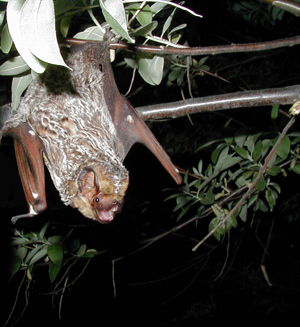 Wind power takes a toll on migratory bats Wind power takes a toll on migratory bats But learning bat migration patterns may save them from wind turbines Jeremy Hance mongabay.com September 12, 2007 The danger of wind turbines to birds has long been known and well documented. Most recently several studies and articles have attempted […]
Wind power takes a toll on migratory bats Wind power takes a toll on migratory bats But learning bat migration patterns may save them from wind turbines Jeremy Hance mongabay.com September 12, 2007 The danger of wind turbines to birds has long been known and well documented. Most recently several studies and articles have attempted […]
Saving beautiful – and ugly – species from extinction
 Saving beautiful – and ugly – species from extinction Saving the beautiful – and the ugly – creatures of the world Why the EDGE Matters Jeremy Hance August 30, 2007 Allow me to wax poetic about the world’s newest wildlife organization, EDGE. I must admit I’m a little in love. This singular organization was founded […]
Saving beautiful – and ugly – species from extinction Saving the beautiful – and the ugly – creatures of the world Why the EDGE Matters Jeremy Hance August 30, 2007 Allow me to wax poetic about the world’s newest wildlife organization, EDGE. I must admit I’m a little in love. This singular organization was founded […]
Clearing rainforest for cattle pasture drives surge in vampires
Clearing rainforest for cattle pasture drives surge in vampires Clearing rainforest for cattle pasture drives surge in vampires mongabay.com August 15, 2007 A new study confirms that vampire bats are thriving due to the clearing of rainforest for cattle pasture in Costa Rica. Instead of having to seek out scarce wildlife in the forest, vampire […]
Nectar feeding bats are powered by pure sugar
Nectar feeding bats are powered by pure sugar Nectar feeding bats are powered by pure sugar mongabay.com August 6, 2007 Nectar-feeding bats are particularly vulnerable to environmental change due to their high-energy dietary requirements, reports a new study published in the British Ecological Society’s journal Functional Ecology. Studying a captive breeding colony of long-tongued bats […]
Fruit bats crave sugar to overcome ‘hangover’
Fruit bats crave sugar to overcome “hangover” Fruit bats crave sugar to overcome “hangover” Society for Experimental Biology April 1, 2007 Many of us will be familiar with cravings for sweet food, after having overindulged in alcohol the night before. It appears that Egyptian fruit bats also crave particular types of sugar to reduce the […]
15 ‘new’ bird species revealed in North America
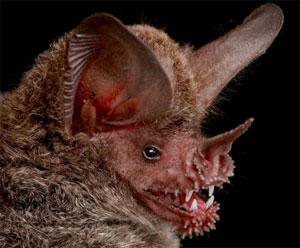 15 ‘new’ bird species revealed in North America 15 ‘new’ bird species revealed in North America mongabay.com February 18, 2007 DNA testing has revealed 15 “new” species of birds in North America and six “new” species of bats from the South American country of Guyana, according to a paper appearing in the British journal Molecular […]
15 ‘new’ bird species revealed in North America 15 ‘new’ bird species revealed in North America mongabay.com February 18, 2007 DNA testing has revealed 15 “new” species of birds in North America and six “new” species of bats from the South American country of Guyana, according to a paper appearing in the British journal Molecular […]
Rare giant bat eats night-flying birds
 Night-flying birds do have predators Rare giant bat eats night-flying birds Turns out night-flying birds do have predators mongabay.com February 13, 2007 A new study published in PLoS ONE, an open online journal, reports that nocturnally migrating songbirds are preyed upon by giant bats. The findings go against the belief that night-flying birds lacked predators. […]
Night-flying birds do have predators Rare giant bat eats night-flying birds Turns out night-flying birds do have predators mongabay.com February 13, 2007 A new study published in PLoS ONE, an open online journal, reports that nocturnally migrating songbirds are preyed upon by giant bats. The findings go against the belief that night-flying birds lacked predators. […]
Audible warfare: how moths avoid bats
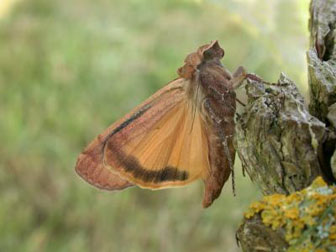 Audible warfare: how moths avoid bats Audible warfare: how moths avoid bats mongabay.com December 18, 2006 A new study published in Current Biology suggests bats and moths may be engaged in evolutionary warfare when it comes to their sense of hearing. The new research, conducted by James Windmill and colleagues at the University of Bristol, […]
Audible warfare: how moths avoid bats Audible warfare: how moths avoid bats mongabay.com December 18, 2006 A new study published in Current Biology suggests bats and moths may be engaged in evolutionary warfare when it comes to their sense of hearing. The new research, conducted by James Windmill and colleagues at the University of Bristol, […]
Animal pollinators responsible for 35 percent of world food crop
 Animal pollinators responsible for 35 percent of world food crop Animal pollinators responsible for 35 percent of world food crop mongabay.com October 25, 2006 A new study calculates that 35 percent of the world’s crop production is dependent on pollinators, like bats, bees, and birds. The research suggests that biodiversity loss could directly impact global […]
Animal pollinators responsible for 35 percent of world food crop Animal pollinators responsible for 35 percent of world food crop mongabay.com October 25, 2006 A new study calculates that 35 percent of the world’s crop production is dependent on pollinators, like bats, bees, and birds. The research suggests that biodiversity loss could directly impact global […]
Bats Hunt Using Guided Missile Strategy
 Bats Hunt Using Guided Missile Strategy Bats Hunt Using Guided Missile Strategy University of Maryland May 4, 2006 When it comes to rocket science, it looks like bats had it worked out before the scientists did. A new University of Maryland study finds that echolocating bats use a strategy to track and catch erratically moving […]
Bats Hunt Using Guided Missile Strategy Bats Hunt Using Guided Missile Strategy University of Maryland May 4, 2006 When it comes to rocket science, it looks like bats had it worked out before the scientists did. A new University of Maryland study finds that echolocating bats use a strategy to track and catch erratically moving […]
Sex vs. Intelligence: Bigger balls mean smaller brain
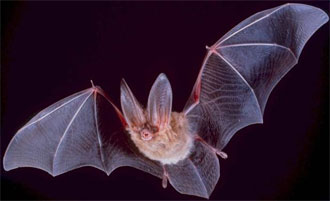 Sex vs. Intelligence: Bigger balls mean smaller brain Sex vs. Intelligence: Bigger balls mean smaller brain Rhett A. Butler, mongabay.com December 13, 2005 In a recent study of bats, Scott Pitnick, professor of biology at Syracuse University, found that testis size is inversely related to brain size. In other words, the bigger the balls of […]
Sex vs. Intelligence: Bigger balls mean smaller brain Sex vs. Intelligence: Bigger balls mean smaller brain Rhett A. Butler, mongabay.com December 13, 2005 In a recent study of bats, Scott Pitnick, professor of biology at Syracuse University, found that testis size is inversely related to brain size. In other words, the bigger the balls of […]
Vampires kill 23 in Brazil, deforestation blamed
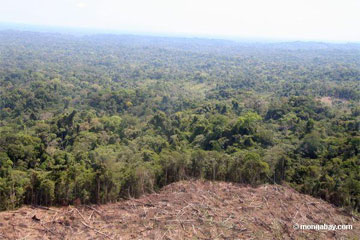 Vampires kill 23 in Brazil, deforestation blamed Vampires kill 23 in Brazil, deforestation blamed mongabay.com November 7, 2005 Rabid vampire bats killed 23 people and attacked more than 1,000 Brazilian officials confirmed last week. The bats have been displaced from their normal rain forest environment by worsening deforestation in the region. In an attempt to […]
Vampires kill 23 in Brazil, deforestation blamed Vampires kill 23 in Brazil, deforestation blamed mongabay.com November 7, 2005 Rabid vampire bats killed 23 people and attacked more than 1,000 Brazilian officials confirmed last week. The bats have been displaced from their normal rain forest environment by worsening deforestation in the region. In an attempt to […]
Now identified as likely origin of SARS; will bats be killed in China?
Now identified as likely origin of SARS; will bats be killed in China Now identified as likely origin of SARS; will bats be killed in China? mongabay.com editorial comment September 29, 2005 The likely source of the respiratory disease SARS is the horseshoe bat, a new study in the journal Science suggests. Researchers found a […]
Birds and Bats Responsible for Seed Dispersal in Tropical Forests
Birds and Bats Responsible for Seed Dispersal in Tropical Forests Birds and Bats Responsible for Seed Dispersal in Tropical Forests University of Illinois press release September 27, 2005 EDITOR’S NOTE: Scientists believe they may have found a way to regrow tropical forest on deforested lands. The plan would involve planting fast-growing, fruit-producing trees, like figs, […]
Organic farming benefits wildlife over conventional agriculture says study
Organic farming benefits wildlife over conventional agriculture says study Organic farming benefits wildlife over conventional agriculture says study British Trust for Ornithology release August 3, 2005 In the largest and most comprehensive study* of organic farming to date, published today in the Royal Society Journal, Biology Letters, scientists from leading UK institutions show conclusively that […]
Progress made in fighting deadly virus spread by pigs and bats
Progress made in fighting deadly virus spread by pigs and bats Progress made in fighting deadly virus spread by pigs and bats mongabay.com July 6, 2005 According to two new reports in Nature and Proceedings of the National Academy of Sciences, scientists have made an important breakthrough in the effort to fight the deadly Nipah […]
Feeds: news | india | latam | brasil | indonesia
 A biologist known as Bolivia’s Batman, ground zero for Amazon deforestation in Peru, and camera traps showing the bird species from ancient cave drawings were among the top stories from our Spanish-language service, Mongabay Latam. Bolivia’s Batman: “There are many more bat species here” “Colombia gets the gold medal” for having the highest number of […]
A biologist known as Bolivia’s Batman, ground zero for Amazon deforestation in Peru, and camera traps showing the bird species from ancient cave drawings were among the top stories from our Spanish-language service, Mongabay Latam. Bolivia’s Batman: “There are many more bat species here” “Colombia gets the gold medal” for having the highest number of […] The world’s tropical forests are threatened by deforestation due to agricultural, industrial and urban expansion; as well as by drought, fire, and disease, all worsened by climate change. Human reforestation efforts are limited by budget and capacity, so the restoration of degraded habitats by means of animal seed dispersal is essential to the future of […]
The world’s tropical forests are threatened by deforestation due to agricultural, industrial and urban expansion; as well as by drought, fire, and disease, all worsened by climate change. Human reforestation efforts are limited by budget and capacity, so the restoration of degraded habitats by means of animal seed dispersal is essential to the future of […] Sunda flying fox silhouettes against the sunset. Photo by: Tiffany Roufs. Rain or clear, wind or still, full moon or no. Every night thousands of flying foxes rise from a small mangrove island among the lesser Sunda islands of Indonesia. Around sunset the Sunda flying fox (Acerodon mackloti) begin to stir in their roots—their stomachs […]
Sunda flying fox silhouettes against the sunset. Photo by: Tiffany Roufs. Rain or clear, wind or still, full moon or no. Every night thousands of flying foxes rise from a small mangrove island among the lesser Sunda islands of Indonesia. Around sunset the Sunda flying fox (Acerodon mackloti) begin to stir in their roots—their stomachs […] Tracking lions, photographing bats, collecting insects, bringing elephants home: it’s all part of a day’s work in Gorongosa National Park. This vast wilderness in Mozambique—including savannah and montane rainforest—was ravaged by civil war in the 1980s and 90s. However, a unique and ambitious 20-year-effort spearheaded by Greg Carr through the Gorongosa Restoration Project—and partnering with […]
Tracking lions, photographing bats, collecting insects, bringing elephants home: it’s all part of a day’s work in Gorongosa National Park. This vast wilderness in Mozambique—including savannah and montane rainforest—was ravaged by civil war in the 1980s and 90s. However, a unique and ambitious 20-year-effort spearheaded by Greg Carr through the Gorongosa Restoration Project—and partnering with […] Straw-colored fruit bat (Eidolon helvum) at the Zoological Garden Berlin, Germany. This species, along with other fruit bats, is present in the Ebola impacted area and may have been a carrier. Photo by: Fritz Geller-Grimm/Creative Commons 2.5. The Ebola outbreak in West Africa may have been the result of complex economic and agricultural policies developed […]
Straw-colored fruit bat (Eidolon helvum) at the Zoological Garden Berlin, Germany. This species, along with other fruit bats, is present in the Ebola impacted area and may have been a carrier. Photo by: Fritz Geller-Grimm/Creative Commons 2.5. The Ebola outbreak in West Africa may have been the result of complex economic and agricultural policies developed […] Big-fanged bat threatened by dam construction New bat, Hypsugo dolichodon, showing off its remarkable canines. Photo by: Judith L. Eger. What big teeth you have, my dear! The better to eat insects with—and make one’s own ecological niche. Scientists have uncovered a new bat with stupendous canines in the rainforests of Lao PDR and Vietnam, […]
Big-fanged bat threatened by dam construction New bat, Hypsugo dolichodon, showing off its remarkable canines. Photo by: Judith L. Eger. What big teeth you have, my dear! The better to eat insects with—and make one’s own ecological niche. Scientists have uncovered a new bat with stupendous canines in the rainforests of Lao PDR and Vietnam, […] Despite vast forest loss, the Anjouan scops owl is holding on in the Comoros Islands The Anjouan scops owl. Photo by: Alan Van Norman. The Anjouan scops owl—an elusive owl found only on its tiny eponymous island—was once considered among the world’s most endangered owls, and even the most threatened birds. However, the first in-depth […]
Despite vast forest loss, the Anjouan scops owl is holding on in the Comoros Islands The Anjouan scops owl. Photo by: Alan Van Norman. The Anjouan scops owl—an elusive owl found only on its tiny eponymous island—was once considered among the world’s most endangered owls, and even the most threatened birds. However, the first in-depth […] West African country lost 4.4 percent of forests in 12 years, new incentives may help stymie future destruction Liberia is one of the last strongholds of intact forest in West Africa. These forests are the home of many unique species of plants and animals. They are important for human communities, as well. Many Liberians rely […]
West African country lost 4.4 percent of forests in 12 years, new incentives may help stymie future destruction Liberia is one of the last strongholds of intact forest in West Africa. These forests are the home of many unique species of plants and animals. They are important for human communities, as well. Many Liberians rely […] A ground-breaking bat call library is released from one of India’s biodiversity hotspots The Western Ghats is one of the world’s eight richest biodiversity hotspots. A UNESCO World Heritage site, and also known as the Great Escarpment of India, the Ghats run parallel to India’s west coast. This great ecosystem is home to over 139 […]
A ground-breaking bat call library is released from one of India’s biodiversity hotspots The Western Ghats is one of the world’s eight richest biodiversity hotspots. A UNESCO World Heritage site, and also known as the Great Escarpment of India, the Ghats run parallel to India’s west coast. This great ecosystem is home to over 139 […] New research in Thailand finds birds and bats key to reforestation efforts Tropical forest restoration projects are exciting research sites for scientists studying factors that affect ecosystem recovery. Here, scientists are trying to understand plant community succession, i.e. the process of recovery after cleared lands are abandoned and allowed to regrow naturally. One of the […]
New research in Thailand finds birds and bats key to reforestation efforts Tropical forest restoration projects are exciting research sites for scientists studying factors that affect ecosystem recovery. Here, scientists are trying to understand plant community succession, i.e. the process of recovery after cleared lands are abandoned and allowed to regrow naturally. One of the […] Development of roads and other structures disturb large, continuous patches of habitat for wildlife. This habitat fragmentation is one of the biggest contributors to species extinction, as the local ecology and species interactions are altered. A new study published in mongabay.com’s open-access journal Tropical Conservation Science finds that leaf-nosed bat abundances in Mexico are closely […]
Development of roads and other structures disturb large, continuous patches of habitat for wildlife. This habitat fragmentation is one of the biggest contributors to species extinction, as the local ecology and species interactions are altered. A new study published in mongabay.com’s open-access journal Tropical Conservation Science finds that leaf-nosed bat abundances in Mexico are closely […] The world’s worst Ebola outbreak was likely begun by a hunter shooting a fruit bat for their dinner or the market, according to the UN. The outbreak has killed over 660 people in six months to date, and recently spread via plane to Nigeria. The disease is particularly deadly with a mortality rate of around […]
The world’s worst Ebola outbreak was likely begun by a hunter shooting a fruit bat for their dinner or the market, according to the UN. The outbreak has killed over 660 people in six months to date, and recently spread via plane to Nigeria. The disease is particularly deadly with a mortality rate of around […] As an environmental journalist covering stories from the great Arctic ice melt to the rhino poaching crisis in Africa, you’ll forgive me if sometimes in the morning—before I turn my computer on—I have a sudden desire to spend a few extra minutes in bed or have a leisurely breakfast with my daughter or just sit […]
As an environmental journalist covering stories from the great Arctic ice melt to the rhino poaching crisis in Africa, you’ll forgive me if sometimes in the morning—before I turn my computer on—I have a sudden desire to spend a few extra minutes in bed or have a leisurely breakfast with my daughter or just sit […] In 1890 Lamberto Loria collected 45 specimens—all female—of a small bat from the wilds of Papua New Guinea. Nearly 25 years later, in 1914, the species was finally described and named by British zoologist Oldfield Thomas, who dubbed it the New Guinea big-eared bat (Pharotis imogene) after its massive ears. But no one ever saw […]
In 1890 Lamberto Loria collected 45 specimens—all female—of a small bat from the wilds of Papua New Guinea. Nearly 25 years later, in 1914, the species was finally described and named by British zoologist Oldfield Thomas, who dubbed it the New Guinea big-eared bat (Pharotis imogene) after its massive ears. But no one ever saw […] Species monitoring can be a very invasive form of research. For instance, bird-banding – in which identification bands are placed around birds’ legs to track their movements – usually requires first catching them in nets. However, the use of non-invasive techniques made possible through advancements in technology has been on the rise. A new study […]
Species monitoring can be a very invasive form of research. For instance, bird-banding – in which identification bands are placed around birds’ legs to track their movements – usually requires first catching them in nets. However, the use of non-invasive techniques made possible through advancements in technology has been on the rise. A new study […] The Theory of Island Biogeography, coined by Robert MacArthur and E.O. Wilson, helps describe why species are distributed as they are. The larger and closer an island is to another (or to the mainland), the more biodiverse it should be. This can be used to describe actual islands in the ocean, like the Galapagos, or […]
The Theory of Island Biogeography, coined by Robert MacArthur and E.O. Wilson, helps describe why species are distributed as they are. The larger and closer an island is to another (or to the mainland), the more biodiverse it should be. This can be used to describe actual islands in the ocean, like the Galapagos, or […] In a cave in Australia, researchers from the University of New South Wales discovered giant fossilized sperm. The sperm were produced 17 million years ago by a group of tiny, shelled crustaceans called ostracods, making them the oldest fossilized sperm ever found. The results were published recently in Proceedings of the Royal Society B. The […]
In a cave in Australia, researchers from the University of New South Wales discovered giant fossilized sperm. The sperm were produced 17 million years ago by a group of tiny, shelled crustaceans called ostracods, making them the oldest fossilized sperm ever found. The results were published recently in Proceedings of the Royal Society B. The […] Suren Gazaryan. Photo by: Goldman Environmental Prize. In a country increasingly known for its authoritarian-style crackdown on activists and dissidents, a bat scientist has won a number of impressive victories to protect the dwindling forests of the Western Caucasus. Beginning in the 1990s, Russian chiropterologist Suren Gazaryan led a number of campaigns to fight illegal […]
Suren Gazaryan. Photo by: Goldman Environmental Prize. In a country increasingly known for its authoritarian-style crackdown on activists and dissidents, a bat scientist has won a number of impressive victories to protect the dwindling forests of the Western Caucasus. Beginning in the 1990s, Russian chiropterologist Suren Gazaryan led a number of campaigns to fight illegal […] Fruit-eating bats play an important role in forest regeneration, collecting and spreading seeds far and wide. However, human development may be stymying bat-mediated dispersal. In a new study published in the British Ecological Society’s Journal of Applied Ecology, researchers found that fruit bats avoid feeding in light-polluted areas, which may significantly affect forest growth. Scientists […]
Fruit-eating bats play an important role in forest regeneration, collecting and spreading seeds far and wide. However, human development may be stymying bat-mediated dispersal. In a new study published in the British Ecological Society’s Journal of Applied Ecology, researchers found that fruit bats avoid feeding in light-polluted areas, which may significantly affect forest growth. Scientists […] A team of researchers has discovered a new species of bat in Brazil, which has put a previously known species, Bokermann’s nectar bat (Lonchophylla bokermanni), at risk of extinction. Long thought to comprise one species, the bat populations of the Atlantic Forest and the Cerrado – the tropical savannah of Brazil’s interior – are in […]
A team of researchers has discovered a new species of bat in Brazil, which has put a previously known species, Bokermann’s nectar bat (Lonchophylla bokermanni), at risk of extinction. Long thought to comprise one species, the bat populations of the Atlantic Forest and the Cerrado – the tropical savannah of Brazil’s interior – are in […] An international research team led by Professor Petr Koube and Darina Koubínová has discovered five new species of vesper bats during a series of expeditions to Senegal’s Niokolo-Koba National Park. The new species are considered cryptic, because their genetic makeup is different despite physical similarities. The new bats have yet to be named. This was […]
An international research team led by Professor Petr Koube and Darina Koubínová has discovered five new species of vesper bats during a series of expeditions to Senegal’s Niokolo-Koba National Park. The new species are considered cryptic, because their genetic makeup is different despite physical similarities. The new bats have yet to be named. This was […] A dolphin swimming through the world’s oceans after fish, and a bat flying through the air with its membranous wings to catch insects or eat fruit: at first glance, it looks like no two creatures could be more different. But it turns out they share a superpower – they hunt prey by emitting high-pitched sounds […]
A dolphin swimming through the world’s oceans after fish, and a bat flying through the air with its membranous wings to catch insects or eat fruit: at first glance, it looks like no two creatures could be more different. But it turns out they share a superpower – they hunt prey by emitting high-pitched sounds […] One of the world’s least-known flying foxes could face extinction by rising seas and changing precipitation patterns due to global warming, according to a new study in Zookeys. The research, headed by Donald Buden with the College of Micronesia, is the first in-depth study of the resident bats of the remote Mortlock Islands, a part […]
One of the world’s least-known flying foxes could face extinction by rising seas and changing precipitation patterns due to global warming, according to a new study in Zookeys. The research, headed by Donald Buden with the College of Micronesia, is the first in-depth study of the resident bats of the remote Mortlock Islands, a part […] Nectar-feeding bats shift the shape of their tongue to slurp up sugar from flowers upon which they feed, finds a new study published in the Proceedings of the National Academy of Sciences. Using histological techniques, high-speed videography, and anatomical studies, Brown University biologist Cally Harper and colleagues found that the bat Glossophaga soricina relies on […]
Nectar-feeding bats shift the shape of their tongue to slurp up sugar from flowers upon which they feed, finds a new study published in the Proceedings of the National Academy of Sciences. Using histological techniques, high-speed videography, and anatomical studies, Brown University biologist Cally Harper and colleagues found that the bat Glossophaga soricina relies on […] Scientists have uncovered a rare, brilliantly-striped bat in South Sudan that has yielded new secrets after close study. Working in Bangangai Game Reserve during July of last year, biologist DeeAnn Redeer and conservationist Adrian Garsdie with Fauna & Flora International (FFI) came across an unmissable bat, which has been dubbed by various media outlets as […]
Scientists have uncovered a rare, brilliantly-striped bat in South Sudan that has yielded new secrets after close study. Working in Bangangai Game Reserve during July of last year, biologist DeeAnn Redeer and conservationist Adrian Garsdie with Fauna & Flora International (FFI) came across an unmissable bat, which has been dubbed by various media outlets as […] A change in prey abundance due to climate change could impact the lesser mouse-eared bat (Myotis blythii). Photo by: Christoph F. Robiller. Global climate change could devastate bat populations around the world, threatening to tear yet another thread from the tapestry of biodiversity should current temperature trends persist, according to a new study. “Bats were […]
A change in prey abundance due to climate change could impact the lesser mouse-eared bat (Myotis blythii). Photo by: Christoph F. Robiller. Global climate change could devastate bat populations around the world, threatening to tear yet another thread from the tapestry of biodiversity should current temperature trends persist, according to a new study. “Bats were […]-Bubble-jetting-emperors-.568.jpg) This was the image Paul had been so hoping to get: a sunlit mass of emperor penguins charging upwards, leaving in their wake a crisscross of bubble trails. The location was near the emperor colony at the edge of the frozen area of the Ross Sea, Antarctica. It was into the only likely exit hole […]
This was the image Paul had been so hoping to get: a sunlit mass of emperor penguins charging upwards, leaving in their wake a crisscross of bubble trails. The location was near the emperor colony at the edge of the frozen area of the Ross Sea, Antarctica. It was into the only likely exit hole […] Pteropus vampyrus hanging in tree in Sierra Madre Natural Park, Philippines. Photo by: Bigstock. Bushmeat hunting is well-known to be decimating animal populations in Africa, but has been little studied much of Southeast Asia. However, a new paper in mongabay.com’s open access journal Tropical Conservation Science shines light on the size and scale of bushmeat […]
Pteropus vampyrus hanging in tree in Sierra Madre Natural Park, Philippines. Photo by: Bigstock. Bushmeat hunting is well-known to be decimating animal populations in Africa, but has been little studied much of Southeast Asia. However, a new paper in mongabay.com’s open access journal Tropical Conservation Science shines light on the size and scale of bushmeat […] The three-toed pygmy sloth. Photo © Craig Turner/ZSL. The pygmy three-toed sloth (Bradypus pygmaeus) is one of the world’s most endangered mammals, according to a detailed survey of the population, which found less than 100 sloths hanging on in their island home. Only described by researchers in 2001, the pygmy sloth lives on a single […]
The three-toed pygmy sloth. Photo © Craig Turner/ZSL. The pygmy three-toed sloth (Bradypus pygmaeus) is one of the world’s most endangered mammals, according to a detailed survey of the population, which found less than 100 sloths hanging on in their island home. Only described by researchers in 2001, the pygmy sloth lives on a single […] Now extinct: the Christmas Island pipistrelle. Photo by: Lindy Lumsden. Nights on Christmas Island in the Indian Ocean will never again be the same. The last echolocation call of a tiny bat native to the island, the Christmas Island pipistrelle (Pipistrellus murrayi), was recorded on August 26th 2009, and since then there has been only […]
Now extinct: the Christmas Island pipistrelle. Photo by: Lindy Lumsden. Nights on Christmas Island in the Indian Ocean will never again be the same. The last echolocation call of a tiny bat native to the island, the Christmas Island pipistrelle (Pipistrellus murrayi), was recorded on August 26th 2009, and since then there has been only […] Indian flying fox soaring at the WCS Bronx Zoo. Photo by: Julie Larsen Maher/WCS. Indian flying foxes (Pteropus giganteus) are now soaring a the Wildlife Conservation Society’s (WCS) Bronx Zoo. With wingspans that reach 4 to 5 feet (1.2-1.5 meters), they are one of the world’s largest bats. “Bats are a vital part of the […]
Indian flying fox soaring at the WCS Bronx Zoo. Photo by: Julie Larsen Maher/WCS. Indian flying foxes (Pteropus giganteus) are now soaring a the Wildlife Conservation Society’s (WCS) Bronx Zoo. With wingspans that reach 4 to 5 feet (1.2-1.5 meters), they are one of the world’s largest bats. “Bats are a vital part of the […].360.jpg) In just six years around six million bats have succumbed to white-nose syndrome in North America, according to U.S. federal researchers. The number, somewhere between 5.7 and 6.7 million bats, is far higher than past estimates of over a million. Showing up in 2006 in New York, the perplexing disease, which appears as white dust […]
In just six years around six million bats have succumbed to white-nose syndrome in North America, according to U.S. federal researchers. The number, somewhere between 5.7 and 6.7 million bats, is far higher than past estimates of over a million. Showing up in 2006 in New York, the perplexing disease, which appears as white dust […].360.jpg) First identified in 2005, white-nose syndrome has killed over a million bats in the US, pushing once common species to the edge of collapse and imperiling already-endangered species. Striking when bats hibernate, the disease leaves a white dust on the bat’s muzzle, causing them to starve to death. Long believed to be caused by a […]
First identified in 2005, white-nose syndrome has killed over a million bats in the US, pushing once common species to the edge of collapse and imperiling already-endangered species. Striking when bats hibernate, the disease leaves a white dust on the bat’s muzzle, causing them to starve to death. Long believed to be caused by a […] Everyone loves the beautiful animals, the playful orangutans, the rolly-polly pandas, the regal tigers, the wise elephants, the awe-inspiring whales, the silly penguins—and it shows. Aside from gracing calendars and starring in movies, these species receive millions in conservation funds and have no shortage of researchers devoted to them. But what about the ugly, crawly, […]
Everyone loves the beautiful animals, the playful orangutans, the rolly-polly pandas, the regal tigers, the wise elephants, the awe-inspiring whales, the silly penguins—and it shows. Aside from gracing calendars and starring in movies, these species receive millions in conservation funds and have no shortage of researchers devoted to them. But what about the ugly, crawly, […] Murina walstoni, a new bat species named after Joe Walston, Wildlife Conservation Society’s (WCS) Executive Director for Asia Programs. Photo by: Gabor Csorba. In the forests of Cambodia and Vietnam, researchers have discovered three new species of tube-nosed bats, known for extraordinary nostrils that look like blooming flowers. The new bats, described in the Journal […]
Murina walstoni, a new bat species named after Joe Walston, Wildlife Conservation Society’s (WCS) Executive Director for Asia Programs. Photo by: Gabor Csorba. In the forests of Cambodia and Vietnam, researchers have discovered three new species of tube-nosed bats, known for extraordinary nostrils that look like blooming flowers. The new bats, described in the Journal […] Although the international program Reduced Emissions from Deforestation and Degradation (REDD) was developed in order to lower greenhouse gas emissions by protecting standing forests, conservationists have long pointed out that another result from a well-crafted REDD program could be to conserve biodiversity. But one of the difficulties of including biodiversity is how to measure the […]
Although the international program Reduced Emissions from Deforestation and Degradation (REDD) was developed in order to lower greenhouse gas emissions by protecting standing forests, conservationists have long pointed out that another result from a well-crafted REDD program could be to conserve biodiversity. But one of the difficulties of including biodiversity is how to measure the […] Murina beelzebub © Gabor Csorba/HNHM. Scientists have discovered three previously unknown bat species in southern Indochina, reports Fauna & Flora International. Researchers from Hungarian Natural History Museum (HNHM) and Fauna & Flora International (FFI) described the new species, which belong to a group known as tube-nosed bats. One of the species, found in Vietnam and […]
Murina beelzebub © Gabor Csorba/HNHM. Scientists have discovered three previously unknown bat species in southern Indochina, reports Fauna & Flora International. Researchers from Hungarian Natural History Museum (HNHM) and Fauna & Flora International (FFI) described the new species, which belong to a group known as tube-nosed bats. One of the species, found in Vietnam and […] New bat species from St. Vincent has been named Garifuna bat. Photo by: Peter A. Larsen. Researchers have declared a new species of bat from the Caribbean island of St. Vincent. While the new bat had been documented before, it was long believed to be a member of a similar species that is found throughout […]
New bat species from St. Vincent has been named Garifuna bat. Photo by: Peter A. Larsen. Researchers have declared a new species of bat from the Caribbean island of St. Vincent. While the new bat had been documented before, it was long believed to be a member of a similar species that is found throughout […] US agriculture stands to lose billions in free ecosystem services from the often-feared and rarely respected humble bat. According to a recent study in Science bats in North America provide the US agricultural industry at least $3.7 billion and up to a staggering $53 billion a year by eating mounds of potentially pesky insects. Yet […]
US agriculture stands to lose billions in free ecosystem services from the often-feared and rarely respected humble bat. According to a recent study in Science bats in North America provide the US agricultural industry at least $3.7 billion and up to a staggering $53 billion a year by eating mounds of potentially pesky insects. Yet […] A tiny species of bat in Borneo has chosen an unusual roost: a carnivorous pitcher plant, according to a recent study. The study examines how this behavior actually benefits both the bats and the plants, creating a symbiotic relationship. In the Biology Letters‘s study, Hardwicke’s woolly bats (Kerivoula hardwickii) were found to consistently roost in […]
A tiny species of bat in Borneo has chosen an unusual roost: a carnivorous pitcher plant, according to a recent study. The study examines how this behavior actually benefits both the bats and the plants, creating a symbiotic relationship. In the Biology Letters‘s study, Hardwicke’s woolly bats (Kerivoula hardwickii) were found to consistently roost in […] The conservation program, EDGE, takes a second look at the world’s unique and threatened mammals. What do the New Zealand greater short-tailed bat, the black-and-white ruffed lemur, and the numbat have in common? They are all new members of the Zoological Society of London’s EDGE’s top 100 most endangered and unique mammals list. Arguably the […]
The conservation program, EDGE, takes a second look at the world’s unique and threatened mammals. What do the New Zealand greater short-tailed bat, the black-and-white ruffed lemur, and the numbat have in common? They are all new members of the Zoological Society of London’s EDGE’s top 100 most endangered and unique mammals list. Arguably the […] Although the first specimen was collected over 30 years ago, scientists have only now confirmed that a tiny brown bat is indeed a unique species. Named Myotis diminutus for its incredibly small size, the new bat was discovered in the Chocó biodiversity hotspot, amid the moist forests of western Ecuador. “There are more than one […]
Although the first specimen was collected over 30 years ago, scientists have only now confirmed that a tiny brown bat is indeed a unique species. Named Myotis diminutus for its incredibly small size, the new bat was discovered in the Chocó biodiversity hotspot, amid the moist forests of western Ecuador. “There are more than one […] Researchers have uncovered an astounding number of species in a tiny protected forest fragment surrounded on all side by palm oil plantations in the Indonesian island of Sumatra. Researchers with the Zoological Society of London (ZSL), Queen Mary, University of London and the Durrell Institute of Conservation and Ecology (DICE – University of Kent) recorded […]
Researchers have uncovered an astounding number of species in a tiny protected forest fragment surrounded on all side by palm oil plantations in the Indonesian island of Sumatra. Researchers with the Zoological Society of London (ZSL), Queen Mary, University of London and the Durrell Institute of Conservation and Ecology (DICE – University of Kent) recorded […] When people think of the Amazon rainforest, they likely think of roaring jaguars, jumping monkeys, marching ants, and squeezing anacondas. The humble peccary would hardly be among the first animals to cross their mind, if they even know such pig-like animals exists! Yet new research on the peccary is proving just how vital these species […]
When people think of the Amazon rainforest, they likely think of roaring jaguars, jumping monkeys, marching ants, and squeezing anacondas. The humble peccary would hardly be among the first animals to cross their mind, if they even know such pig-like animals exists! Yet new research on the peccary is proving just how vital these species […] An interview with Paula Kahumbu of WildlifeDirect. Rising over 2,500 meters from Kenya’s northern desert, the Mathews Range is a sky island: isolated mountain forests surrounded by valleys. Long cut off from other forests, ‘sky islands’ such as this often contain unique species and ecosystems. Supported by the Nature Conservancy, an expedition including local community […]
An interview with Paula Kahumbu of WildlifeDirect. Rising over 2,500 meters from Kenya’s northern desert, the Mathews Range is a sky island: isolated mountain forests surrounded by valleys. Long cut off from other forests, ‘sky islands’ such as this often contain unique species and ecosystems. Supported by the Nature Conservancy, an expedition including local community […] A new study in Tropical Conservation Science shows that small tropical mammals in Mexico—bats and rodents—require a variety of habitats to thrive. Surveying mammal populations in the Isthmus of Tehuantepec, Oaxaca, Mexico, researchers found that sites comprising the greatest habitat diversity carried also the greatest diversity of rodents. In turn bats lived in all variety […]
A new study in Tropical Conservation Science shows that small tropical mammals in Mexico—bats and rodents—require a variety of habitats to thrive. Surveying mammal populations in the Isthmus of Tehuantepec, Oaxaca, Mexico, researchers found that sites comprising the greatest habitat diversity carried also the greatest diversity of rodents. In turn bats lived in all variety […] The first in an interview series with participants in the 5th Frugivore and Seed Dispersal International Symposium. There are few areas of research in tropical biology more exciting and more important than seed dispersal. Seed dispersal—the process by which seeds are spread from parent trees to new sprouting ground—underpins the ecology of forests worldwide. In […]
The first in an interview series with participants in the 5th Frugivore and Seed Dispersal International Symposium. There are few areas of research in tropical biology more exciting and more important than seed dispersal. Seed dispersal—the process by which seeds are spread from parent trees to new sprouting ground—underpins the ecology of forests worldwide. In […] In the midst of a seesaw political battle to save Yasuni National Park from oil developers, scientists have announced that this park in Ecuador houses more species than anywhere else in South America—and maybe the world. “Yasuní is at the center of a small zone where South America’s amphibians, birds, mammals, and vascular plants all […]
In the midst of a seesaw political battle to save Yasuni National Park from oil developers, scientists have announced that this park in Ecuador houses more species than anywhere else in South America—and maybe the world. “Yasuní is at the center of a small zone where South America’s amphibians, birds, mammals, and vascular plants all […] Seventh in a series of interviews with participants at the 2009 Association of Tropical Biology and Conservation (ATBC) conference. A large flying fox eats a fruit ingesting its seeds. Flying over the tropical forests it eventually deposits the seeds at the base of another tree far from the first. One of these seeds takes root, […]
Seventh in a series of interviews with participants at the 2009 Association of Tropical Biology and Conservation (ATBC) conference. A large flying fox eats a fruit ingesting its seeds. Flying over the tropical forests it eventually deposits the seeds at the base of another tree far from the first. One of these seeds takes root, […] The short-nosed fruit bat Cynopterus sphinx is the first bat species to have been observed engaging in oral sex. New research headed by Min Tan of China’s Guangdong Entomological Institute discovered that female short nosed fruit bats would often lick the shaft of the male bats’ penis during penetration. Before this discovery published in PLoS […]
The short-nosed fruit bat Cynopterus sphinx is the first bat species to have been observed engaging in oral sex. New research headed by Min Tan of China’s Guangdong Entomological Institute discovered that female short nosed fruit bats would often lick the shaft of the male bats’ penis during penetration. Before this discovery published in PLoS […] Cambodia’s Royal Government’s Council of Ministers has declared the creation of the Seima Protection Forest, a 1,100 square miles (2,849 square kilometers) park home to tigers, elephants, and endangered primates. The park’s creation was developed in part by the Wildlife Conservation Society’s (WCS) “Carbon for Conservation” program, which intends to protect high-biodiversity ecosystems while raising […]
Cambodia’s Royal Government’s Council of Ministers has declared the creation of the Seima Protection Forest, a 1,100 square miles (2,849 square kilometers) park home to tigers, elephants, and endangered primates. The park’s creation was developed in part by the Wildlife Conservation Society’s (WCS) “Carbon for Conservation” program, which intends to protect high-biodiversity ecosystems while raising […] A common bird in Europe, the great tit tends to stick to insects and seeds as a food source with caterpillars as a particular favorite. However, a new paper in Biology Letters found that the song bird employs unique feeding behavior in a cave in Hungary: they kill and eat hibernating pipistrelle bats. This is […]
A common bird in Europe, the great tit tends to stick to insects and seeds as a food source with caterpillars as a particular favorite. However, a new paper in Biology Letters found that the song bird employs unique feeding behavior in a cave in Hungary: they kill and eat hibernating pipistrelle bats. This is […] A five week expedition into a remote extinct volcano has uncovered a treasure trove of new species in Papua New Guinea, including what may be the world’s largest rat, a fanged frog, and a grunting fish. In all the expedition estimates it may have found around forty species unknown to science. The expedition was undertaken […]
A five week expedition into a remote extinct volcano has uncovered a treasure trove of new species in Papua New Guinea, including what may be the world’s largest rat, a fanged frog, and a grunting fish. In all the expedition estimates it may have found around forty species unknown to science. The expedition was undertaken […]
 Individual bats have the ability to tell the difference between other bats just by the sound of their voice, according to a study published in PLoS Computational Biology. Researchers from the University of Tuebingen, Germany found that the greater mouse-eared bat could distinguish between their fellows’ echolocation calls. A subject bat was tested by having […]
Individual bats have the ability to tell the difference between other bats just by the sound of their voice, according to a study published in PLoS Computational Biology. Researchers from the University of Tuebingen, Germany found that the greater mouse-eared bat could distinguish between their fellows’ echolocation calls. A subject bat was tested by having […]
 Shade-grown coffee protects more than birds and bats
Shade-grown coffee protects more than birds and bats Limestone karsts – islands of biodiversity in Asia – under threat from mining Limestone karsts – islands of biodiversity in Asia – under threat from mining mongabay.com November 10, 2008
Limestone karsts – islands of biodiversity in Asia – under threat from mining Limestone karsts – islands of biodiversity in Asia – under threat from mining mongabay.com November 10, 2008 Massive bat species returns from the brink of extinction Massive bat species returns from the brink of extinction mongabay.com October 31, 2008
Massive bat species returns from the brink of extinction Massive bat species returns from the brink of extinction mongabay.com October 31, 2008 Researchers have identified the fungus that may have been the culprit in mass die-offs of bats in the northeastern United States during the winter of 2006-2007. The research is published in this week’s issue of Science. During the outbreak, which killed 100,000 hibernating bats, many bats were afflicted with “white-nose” syndrome — a white, powdery-looking […]
Researchers have identified the fungus that may have been the culprit in mass die-offs of bats in the northeastern United States during the winter of 2006-2007. The research is published in this week’s issue of Science. During the outbreak, which killed 100,000 hibernating bats, many bats were afflicted with “white-nose” syndrome — a white, powdery-looking […] Photo: Critically endangered fruit bat born in New York City Critically endangered fruit bat born in New York City mongabay.com August 1, 2008 A critically endangered fruit bat was born last month at the Bronx Zoo. The female Rodriguez fruit bat was born July 6 and has been named “Buffy” by staff Veterinarians at the […]
Photo: Critically endangered fruit bat born in New York City Critically endangered fruit bat born in New York City mongabay.com August 1, 2008 A critically endangered fruit bat was born last month at the Bronx Zoo. The female Rodriguez fruit bat was born July 6 and has been named “Buffy” by staff Veterinarians at the […] Fruit bats frequent clay-licks in the Amazon rainforest Fruit bats frequent clay-licks in the Amazon rainforest Jeremy Hance, mongabay.com July 14, 2008 In the Peru new research finds that female fruit bats are frequent visitors to clay-licks Clay-licks, or collpas as they are called in Peru, are visited by a wide assortment of animals, including […]
Fruit bats frequent clay-licks in the Amazon rainforest Fruit bats frequent clay-licks in the Amazon rainforest Jeremy Hance, mongabay.com July 14, 2008 In the Peru new research finds that female fruit bats are frequent visitors to clay-licks Clay-licks, or collpas as they are called in Peru, are visited by a wide assortment of animals, including […] Bats significantly reduce insect damage to plants, report researchers from the Smithsonian Tropical Research Institute and the University of Michigan. Using nets to control the presence of bats and birds at certain times of the day in a Panamanian rainforest and a Mexican coffee plantation, the scientists found that bats can be more effective pest […]
Bats significantly reduce insect damage to plants, report researchers from the Smithsonian Tropical Research Institute and the University of Michigan. Using nets to control the presence of bats and birds at certain times of the day in a Panamanian rainforest and a Mexican coffee plantation, the scientists found that bats can be more effective pest […] Bats eat as many insects at night as birds do during the day, according to research published in the journal Science. Using nets to control the presence of bats and birds at certain times of the day in the Panamanian rainforest, Margareta Kalka of the Smithsonian Tropical Research Institute and colleagues found that bats have […]
Bats eat as many insects at night as birds do during the day, according to research published in the journal Science. Using nets to control the presence of bats and birds at certain times of the day in the Panamanian rainforest, Margareta Kalka of the Smithsonian Tropical Research Institute and colleagues found that bats have […] Wind power takes a toll on migratory bats Wind power takes a toll on migratory bats But learning bat migration patterns may save them from wind turbines Jeremy Hance mongabay.com September 12, 2007 The danger of wind turbines to birds has long been known and well documented. Most recently several studies and articles have attempted […]
Wind power takes a toll on migratory bats Wind power takes a toll on migratory bats But learning bat migration patterns may save them from wind turbines Jeremy Hance mongabay.com September 12, 2007 The danger of wind turbines to birds has long been known and well documented. Most recently several studies and articles have attempted […] Saving beautiful – and ugly – species from extinction Saving the beautiful – and the ugly – creatures of the world Why the EDGE Matters Jeremy Hance August 30, 2007 Allow me to wax poetic about the world’s newest wildlife organization, EDGE. I must admit I’m a little in love. This singular organization was founded […]
Saving beautiful – and ugly – species from extinction Saving the beautiful – and the ugly – creatures of the world Why the EDGE Matters Jeremy Hance August 30, 2007 Allow me to wax poetic about the world’s newest wildlife organization, EDGE. I must admit I’m a little in love. This singular organization was founded […] 15 ‘new’ bird species revealed in North America 15 ‘new’ bird species revealed in North America mongabay.com February 18, 2007 DNA testing has revealed 15 “new” species of birds in North America and six “new” species of bats from the South American country of Guyana, according to a paper appearing in the British journal Molecular […]
15 ‘new’ bird species revealed in North America 15 ‘new’ bird species revealed in North America mongabay.com February 18, 2007 DNA testing has revealed 15 “new” species of birds in North America and six “new” species of bats from the South American country of Guyana, according to a paper appearing in the British journal Molecular […] Night-flying birds do have predators Rare giant bat eats night-flying birds Turns out night-flying birds do have predators mongabay.com February 13, 2007 A new study published in PLoS ONE, an open online journal, reports that nocturnally migrating songbirds are preyed upon by giant bats. The findings go against the belief that night-flying birds lacked predators. […]
Night-flying birds do have predators Rare giant bat eats night-flying birds Turns out night-flying birds do have predators mongabay.com February 13, 2007 A new study published in PLoS ONE, an open online journal, reports that nocturnally migrating songbirds are preyed upon by giant bats. The findings go against the belief that night-flying birds lacked predators. […] Audible warfare: how moths avoid bats Audible warfare: how moths avoid bats mongabay.com December 18, 2006 A new study published in Current Biology suggests bats and moths may be engaged in evolutionary warfare when it comes to their sense of hearing. The new research, conducted by James Windmill and colleagues at the University of Bristol, […]
Audible warfare: how moths avoid bats Audible warfare: how moths avoid bats mongabay.com December 18, 2006 A new study published in Current Biology suggests bats and moths may be engaged in evolutionary warfare when it comes to their sense of hearing. The new research, conducted by James Windmill and colleagues at the University of Bristol, […] Animal pollinators responsible for 35 percent of world food crop Animal pollinators responsible for 35 percent of world food crop mongabay.com October 25, 2006 A new study calculates that 35 percent of the world’s crop production is dependent on pollinators, like bats, bees, and birds. The research suggests that biodiversity loss could directly impact global […]
Animal pollinators responsible for 35 percent of world food crop Animal pollinators responsible for 35 percent of world food crop mongabay.com October 25, 2006 A new study calculates that 35 percent of the world’s crop production is dependent on pollinators, like bats, bees, and birds. The research suggests that biodiversity loss could directly impact global […] Bats Hunt Using Guided Missile Strategy Bats Hunt Using Guided Missile Strategy University of Maryland May 4, 2006 When it comes to rocket science, it looks like bats had it worked out before the scientists did. A new University of Maryland study finds that echolocating bats use a strategy to track and catch erratically moving […]
Bats Hunt Using Guided Missile Strategy Bats Hunt Using Guided Missile Strategy University of Maryland May 4, 2006 When it comes to rocket science, it looks like bats had it worked out before the scientists did. A new University of Maryland study finds that echolocating bats use a strategy to track and catch erratically moving […] Sex vs. Intelligence: Bigger balls mean smaller brain Sex vs. Intelligence: Bigger balls mean smaller brain Rhett A. Butler, mongabay.com December 13, 2005 In a recent study of bats, Scott Pitnick, professor of biology at Syracuse University, found that testis size is inversely related to brain size. In other words, the bigger the balls of […]
Sex vs. Intelligence: Bigger balls mean smaller brain Sex vs. Intelligence: Bigger balls mean smaller brain Rhett A. Butler, mongabay.com December 13, 2005 In a recent study of bats, Scott Pitnick, professor of biology at Syracuse University, found that testis size is inversely related to brain size. In other words, the bigger the balls of […] Vampires kill 23 in Brazil, deforestation blamed Vampires kill 23 in Brazil, deforestation blamed mongabay.com November 7, 2005 Rabid vampire bats killed 23 people and attacked more than 1,000 Brazilian officials confirmed last week. The bats have been displaced from their normal rain forest environment by worsening deforestation in the region. In an attempt to […]
Vampires kill 23 in Brazil, deforestation blamed Vampires kill 23 in Brazil, deforestation blamed mongabay.com November 7, 2005 Rabid vampire bats killed 23 people and attacked more than 1,000 Brazilian officials confirmed last week. The bats have been displaced from their normal rain forest environment by worsening deforestation in the region. In an attempt to […]